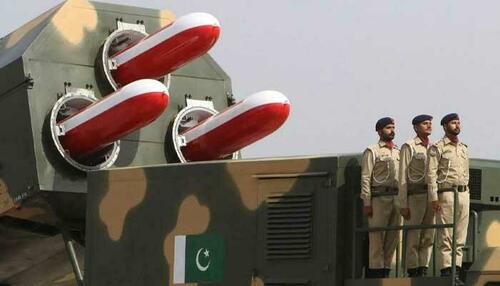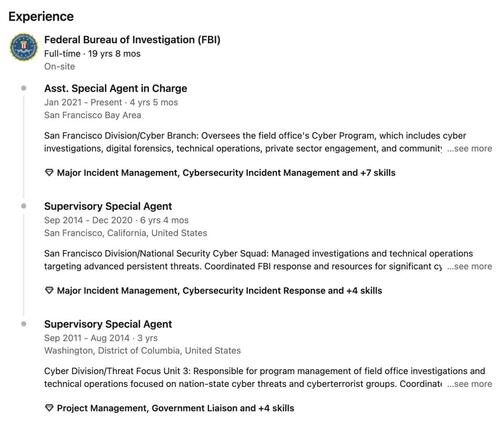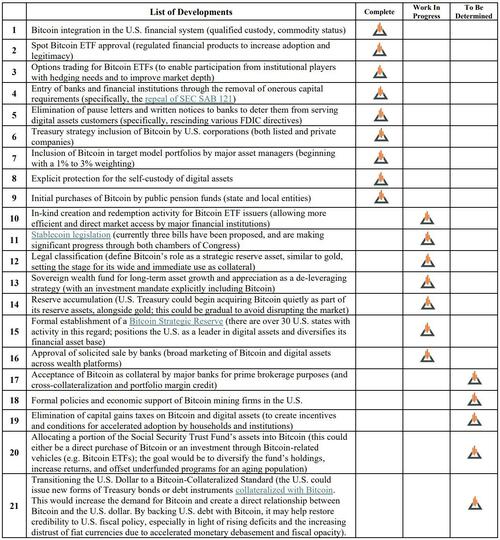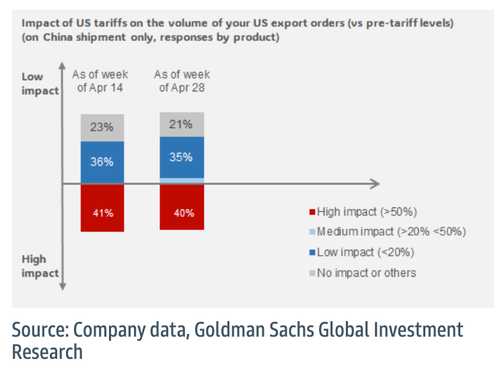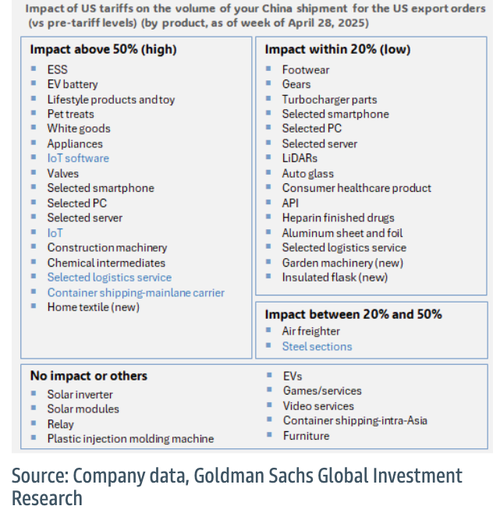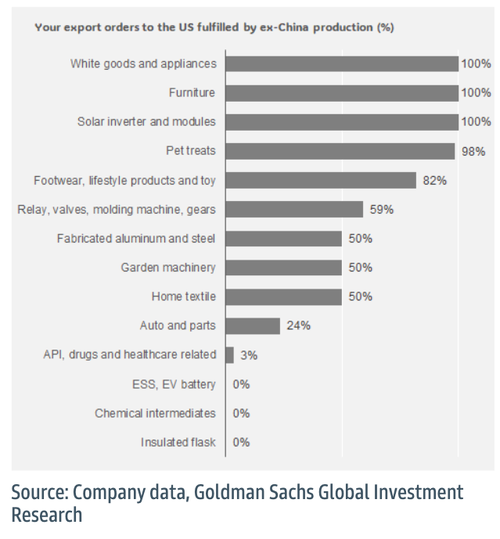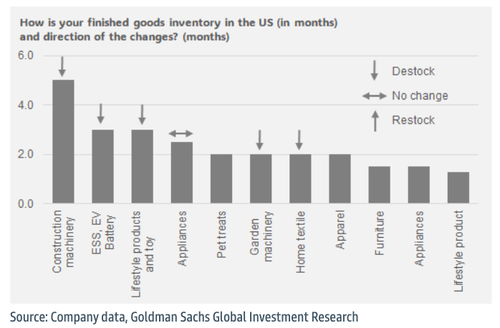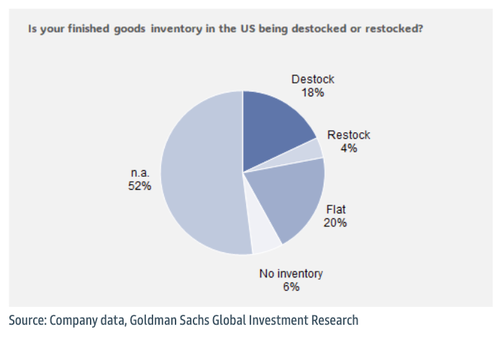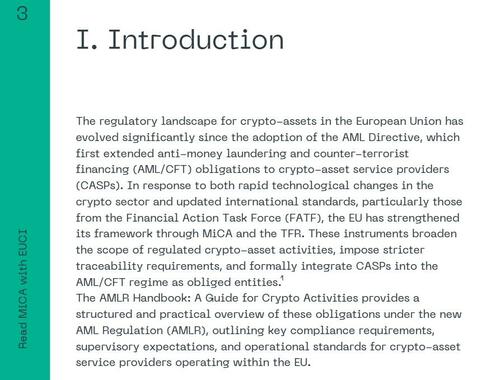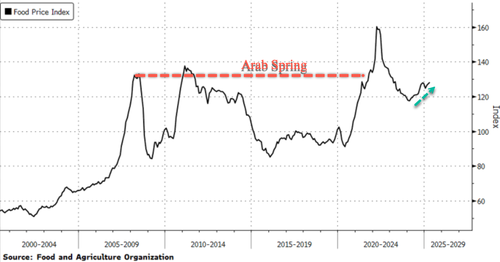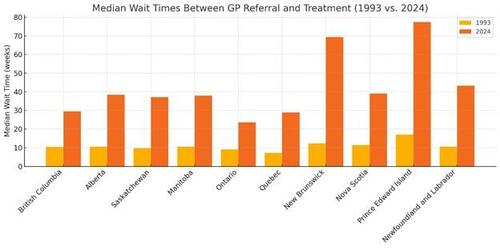Celibacy is always, shall we say, an affront to what man normally thinks. It is something that can be done, and is only credible, if there is a God and if celibacy is my doorway into the kingdom of God.
Distinction Matter - Subscribed Feeds
-
Site: RT - News
An RT video uses a quote from the wartime prime minister praising the Red Army for ‘tearing the guts out of’ the Wehrmacht
RT has released an AI-generated video of former British Prime Minister Winston Churchill speaking about the crucial role of the Soviet Union in the defeat of Nazi Germany and other Axis powers in World War II.
As the world prepares to mark the 80th anniversary of the Allied victory next week, the video responds to a tendency in the West to overlook or downplay the USSR’s contribution. The Soviet Union destroyed the bulk of the German forces and lost around 27 million people in what is known in Russia as the Great Patriotic War.
In the video, Churchill is shown reacting to UK Prime Minister Keir Starmer’s remarks during a visit to the White House in February. “No two countries have done more together to keep people safe,” Starmer said. “And in a few weeks’ time we’ll mark… the 80th anniversary of Victory in Europe. Britain and America fought side-by-side to make that happen.”
Churchill’s quote used in the video is authentic, taken from a letter to Joseph Stalin. “I shall take the occasion to repeat tomorrow in the House of Commons what I have said before, that it is the Russian army that tore the guts out of the German military machine and is at the present moment holding by far the larger portion of the enemy on its front,” he wrote on September 27, 1944.
The letter was written as the Red Army was on the offensive, following its decisive victory over the Wehrmacht in the Battle of Kursk.
-
Site: RT - News
An RT video uses a quote from the wartime prime minister praising the Red Army for ‘tearing the guts out of’ the Wehrmacht
RT has released an AI-generated video of former British Prime Minister Winston Churchill speaking about the crucial role of the Soviet Union in the defeat of Nazi Germany and other Axis powers in World War II.
As the world prepares to mark the 80th anniversary of the Allied victory next week, the video responds to a tendency in the West to overlook or downplay the USSR’s contribution. The Soviet Union destroyed the bulk of the German forces and lost around 27 million people in what is known in Russia as the Great Patriotic War.
In the video, Churchill is shown reacting to UK Prime Minister Keir Starmer’s remarks during a visit to the White House in February. “No two countries have done more together to keep people safe,” Starmer said. “And in a few weeks’ time we’ll mark… the 80th anniversary of Victory in Europe. Britain and America fought side-by-side to make that happen.”
Churchill’s quote used in the video is authentic, taken from a letter to Joseph Stalin. “I shall take the occasion to repeat tomorrow in the House of Commons what I have said before, that it is the Russian army that tore the guts out of the German military machine and is at the present moment holding by far the larger portion of the enemy on its front,” he wrote on September 27, 1944.
The letter was written as the Red Army was on the offensive, following its decisive victory over the Wehrmacht in the Battle of Kursk.
-
Site: Zero HedgeZelensky's Truce Refusal Poses Direct Threat To Visiting Leaders For Victory Day: KremlinTyler Durden Sat, 05/03/2025 - 19:15
Ukraine's President Zelensky has dismissed the Kremlin's unilateral declaration of a three-day ceasefire for Russia's World War II commemorations on May 9 as but a "game" and "theatrical performance".
"This is more of a theatrical performance on his part. Because in two or three days, it is impossible to develop a plan for the next steps to end the war," Zelensky said, offering instead a fuller 30-day ceasefire.
We reported earlier that Zelensky days ago went so far as to hint that a Ukrainian attack on Victory Day events could happen. Here's what Zelensky warned several days ago:
"Now they are worried that their parade is in question, and they are rightly worried. But they should be concerned that this war is still going on. They must end the war," the Ukrainian president said.
Moscow officials certainly took this as a direct threat. Various world leaders, including President Xi Jinping of China, will be present for the V-Day parade through Red Square and other observances. This year's will be particularly special given it's the 80th anniversary since the end of WW2.
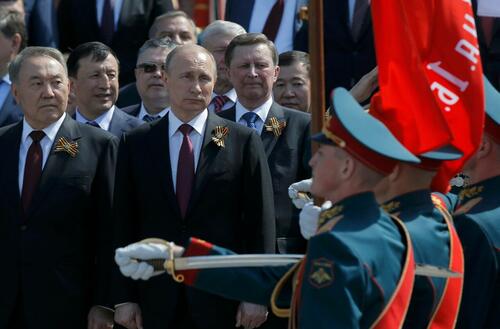 Prior Victory Day event. President Putin attends every year, via Reuters
Prior Victory Day event. President Putin attends every year, via Reuters
Russian Foreign Ministry spokeswoman Maria Zakharova issued a statement Saturday saying that Zelensky "unambiguously threatened world leaders."
"After every terrorist attack on Russia's territory, the Kiev regime, its security services, and Zelensky personally boast that this is their doing, that this will continue. Therefore, the phrase that he 'does not guarantee security on May 9 in Russia' as it is not his area of responsibility is, of course, a direct threat," the diplomat stated.
She and Peskov further blasted Zelensky's stance as having exposed "the neo-Nazi nature of the Kiev regime, which has become a terrorist cell," according to TASS.
Lately there's been assassination bombings targeting top Russian generals, as well as long-range drone attacks which have reached the outskirts of Moscow. Clearly, Ukrainian intelligence and/or its allied Western intel services have made inroads into Russia.
Without doubt, Russian defense and security services will bulk up anti-air systems in an around Moscow for Victory Day events.
Defense officials, heads of state, and foreign ministers from various countries and especially Russia-friendly nations are expected to be present.
Earlier in the Ukraine war, drones were sent across the Russian border and made it all the way to the Moscow Kremlin complex, lightly damaging the top of a dome, in what was a major first at the time. Since then, Moscow area airports have more frequently halted operations during inbound drone attacks.
-
Site: Zero HedgeArtificial General Intelligence (AGI): Can It Really Think Like A Human?Tyler Durden Sat, 05/03/2025 - 18:40
Authored by Jules Winnfield via CoinTelegraph.com,
What is AGI?
When the lines blur between man and machine, you’re looking at artificial general intelligence (AGI). Unlike its counterpart, artificial narrow intelligence (ANI), which is the use of AI for solving individual problem statements, AGI represents artificial intelligence that can understand, learn and apply knowledge in a way that is indistinguishable from human cognition.
AGI is still theoretical, but the prospect of artificial intelligence being able to holistically replace human input and judgment has naturally attracted plenty of interest, with researchers, technologists and academics alike seeking to bring the concept of AGI to reality.
Yet another strand of prevailing research seeks to explore the feasibility and implications of AGI vs. ANI in a world increasingly shaped by AI capabilities.
Indeed, while ANI has already transformed various industries, AGI’s potential goes far beyond. Imagine a world where machines can not only assist humans in their tasks but also proactively understand the drivers behind specific tasks, predict outcomes, and autonomously create innovative solutions to achieve optimal results. This paradigm shift could revolutionize healthcare, education, transportation and countless other fields.
Why is AGI so powerful?
Unlike ANI, AGI is not confined to pre-programmed tasks or predefined responses within a limited domain. Instead, it has the potential to generate and apply knowledge across various contexts.
Imagine a self-driving car powered by AGI. It can collect a passenger from a train station but also personalize the journey with custom recommendations for pit stops, sightseeing avenues or navigating unfamiliar roads to arrive at the desired destination. And because it’s a machine, AGI would not experience fatigue and would continue learning and improving at exponential speeds.
Here’s a definition of AGI by Vitalik Buterin, who highlights the sheer potential of AGI:
The example highlights some interesting features of AGI, which include:
-
Learning capability: AGI can learn from experiences and improve its performance over time without a concerted effort by human programmers to perform additional data set training. This learning is not limited to specific tasks and instead encompasses a broad spectrum of activities.
-
Problem-solving skills: AGI can solve complex problems by applying logical reasoning just as a human would. This includes consideration of non-traditional variables, such as emotional impact, which can highlight an even wider range of potential outcomes.
-
Adaptability: AGI can adjust to new situations and environments without explicit programming, which means it can thrive in dynamic and unpredictable settings.
-
Understanding and interpretation: AGI is equipped to comprehend natural language, abstract concepts and emotional nuance, allowing for sophisticated human-machine interactions.
Did you know? Blockchain timestamps could serve as a legal memory for AGI systems, allowing future audits to determine exactly what an AGI knew — and when.
The pursuit of AGI: Where does it stand as of April 2025?
AGI is currently the science-fiction version of AI. However, while still theoretical, the sheer potential of the concept makes AGI the science fiction equivalent of artificial intelligence.
While existing models, such as ChatGPT, are constantly evolving and improving with each day, the journey to bringing AGI to life involves overcoming significant technical challenges, such as:
-
Defining the tech stack: The purely hypothetical nature of AGI makes it exceedingly difficult, if not altogether impossible, to determine the precise nature of the technological stack required for practical implementation.
-
Neural networks: Advances in deep learning have propelled this field forward, but AGI would also require specialist neural networks that mimic the human brain’s structure to process information and introduce a layer of emotion and nuance.
-
Natural language processing (NLP): Significant advances are required in the field of NLP to enable machines to better understand and generate human language, incorporating nuance, emotion and complexities. This includes a more complex analysis of language syntax, semantics and context, which is still evolving in traditional machine learning models that leverage NLP.
-
Reinforcement learning: Using reward-based mechanisms to teach machines to make decisions would allow AGI to learn optimal behaviors through trial and error.
Despite advancements, creating AGI that can truly think like a human remains an elusive goal.
Did you know? DeepMind warns that not all AI risks come from the machines themselves — some start with humans misusing them. In its paper titled ‘An Approach to Technical AGI Safety and Security’, DeepMind identifies four key threats: misuse (bad actors using AI for harm), misalignment (AI knowingly going against its developer’s intent), mistakes (AI causes harm without realizing it), and structural risks (failures that emerge from complex interactions between people, organizations, or systems).
Can AGI think like a human?
The question of whether AGI can think like a human delves into the very core of human cognition. Human thinking is characterized by consciousness, emotional depth, creativity and subjectivity. While AGI can simulate certain aspects of human thought, replicating the full spectrum of human cognition is a formidable challenge.
Several dimensions of human cognition are particularly difficult to emulate:
-
Consciousness and self-awareness: One of the defining traits of human thinking is consciousness, the awareness of oneself and one’s surroundings. AGI, as sophisticated as it may become, lacks the intrinsic human ability to introspect. AGI operates on an underlying set of algorithms and complex, learned patterns, without any subjectivity or genuine emotion.
-
Emotional intelligence: Humans experience a wide range of emotions that influence their decisions, behaviors and interactions. While AGI can be trained to recognize and respond to such emotions, the lack of genuine emotional experience means that it cannot wholly replicate these emotions. Emotional intelligence in humans involves empathy, compassion and moral considerations, elements that are challenging to encode into machines.
-
Creativity and innovation: Creativity involves generating novel ideas and solutions, often through intuitive leaps and imaginative thinking. AGI can mimic creativity by combining existing knowledge in new ways, but it lacks the intrinsic motivation and subjective insight that drive human innovation. True creativity stems from emotional experiences, personal reflections and cultural contexts, which AGI cannot authentically replicate.
Key benefits of AGI
The litmus test for AGI lies in its ability to holistically replicate a human experience. When realized, the potential benefits are enormous and stretch across various industries, spawning various aspects of daily life.
Despite its limitations, AGI is increasingly viewed as a force for good across a range of industries, including:
-
Healthcare: AGI can assist in diagnosing diseases, developing personalized treatment plans and predicting customized health outcomes, leveraging a vast body of underlying training data.
-
Education: It can provide customized learning experiences, tutoring and academic research support. AGI can adapt to individual learning styles and pace, enhancing educational outcomes.
-
Economics: It can optimize financial models, predict market trends, and enhance productivity. It can analyze economic data to forecast market trends and guide investment decisions.
-
Environmental Science: AGI can analyze climate data, model ecological impacts, and propose sustainable solutions.
Additionally, AGI’s potential extends to areas such as transportation, communication and entertainment, offering new frontiers for innovation.
Did you know? Some futurists believe AGI systems could eventually negotiate with each other autonomously using blockchain-based smart contracts — forming agreements, trading data or even co-developing solutions without human intervention.
Ethical and societal considerations
The rise of AGI raises significant ethical and societal questions.
While powerful, AGI requires careful consideration for safe usage, which has prompted the creation of nonprofit societies, such as the AGI Society, as shown in the image below.
Fundamentally, it is crucial to address concerns such as:
-
Safety: Ensuring AGI operates within safe and controlled parameters to prevent unintended consequences. This includes robust testing and the introduction of regulatory frameworks to oversee AGI deployment.
-
Privacy: Protecting personal data from misuse by AGI systems. As AGI can process vast amounts of data, safeguarding privacy is paramount.
-
Bias and fairness: Preventing discriminatory practices and ensuring equitable access to AGI benefits. Developers must ensure that AGI systems are free from biases that could lead to unfair treatment.
-
Employment: Addressing the impact of AGI on job displacement and workforce dynamics. As AGI automates tasks, there is a need to consider its impact on employment and provide support for affected workers.
The integration of AGI into society requires a thoughtful approach to its governance, ensuring that it serves the common good and respects social values.
Can blockchain power AGI?
AGI could create computers as smart as humans, revolutionizing fields like cryptocurrency trading or market analysis. But AGI needs trust and fairness to work for everyone. Blockchain, the tech behind Bitcoin and Ethereum, offers a secure, transparent way to make this happen.
Here’s how blockchain can supercharge AGI with crypto-inspired solutions:
- Clear training records: Blockchain works like Bitcoin’s open transaction log, recording every piece of data (e.g., crypto trading patterns) used to train AGI. This helps ensure the system is fair and free from hidden biases.
- Shared decision-making: Similar to Ethereum’s smart contracts, blockchain will allow developers, traders and users to vote on AGI’s rules, ensuring no single company controls it.
- Safe data sharing: Like crypto wallets safeguarding funds, blockchain could protect sensitive data from crypto exchanges, allowing secure sharing for AGI training without leaks.
- Rewards for fairness: Developers who build unbiased AGI, such as accurate trading predictors, could earn digital tokens, just like crypto mining rewards, encouraging ethical work.
However, ongoing challenges such as blockchain’s slow speed, delays in crypto transactions and limited storage capacity could make it hard for AGI to process data quickly or handle large datasets.
To make blockchain AGI-ready, researchers are already exploring:
- Offchain storage: Decentralized systems like InterPlanetary File System (IPFS) are used to store large files offchain, while the blockchain keeps only verifiable hashes, reducing congestion.
- Sharding and danksharding: Like Ethereum’s scalability upgrades, sharding splits data across multiple nodes, allowing AGI to process more information without slowing down the network. Also, danksharding, an advanced form of sharding being developed for Ethereum, combines rollups and data availability sampling to scale data access efficiently — ideal for real-time AGI applications.
- Data pruning: Advanced blockchain models like Decentralized Artificial Intelligent Blockchain-based Computing Network (DAIBCN) prune old or irrelevant data, keeping the system lean and optimized for high-demand tasks like AGI. DAIBCN also enables secure, distributed AI computing — blending blockchain trust with AI performance.
The future of AGI
Artificial general intelligence represents the pinnacle of AI development, promising capabilities that rival human intellect.
While AGI can simulate aspects of human thinking, achieving true human-like cognition remains a distant goal. Consciousness, emotional depth and creativity are intrinsic to human experience and pose significant challenges for AGI.
Nevertheless, the pursuit of AGI continues to drive innovation and reshape our understanding of intelligence. As we advance toward this frontier, it is imperative to navigate ethical considerations and societal impacts to responsibly harness AGI’s potential.
Ongoing research, identifying practical opportunities and technical requirements, and initiating dialogue across society are all essential steps to address the challenges and opportunities posed by AGI.
The future of AGI holds promise, but it requires a balanced approach to ensure that its eventual integration into society enhances human well-being and respects ethical standards.
-
-
Site: Zero HedgePakistan Test-Fires Nuke-Capable Ballistic Missile As Tensions With India SoarTyler Durden Sat, 05/03/2025 - 18:05
Pakistan's military has announced the successful test-firing of a ballistic missile as tensions with fellow nuclear-armed neighbor India grow following the terror attack on Indian-administered Kashmir last month, which resulted in 26 civilians massacred.
Pakistan's government unveiled that it was Abdali Weapon System, a surface-to-surface missile with a range of 450km (280 miles), which can deliver either conventional or nuclear warheads.
The statement underscored that the launch was "aimed at ensuring the operational readiness of troops and validating key technical parameters, including the missile’s advanced navigation system and enhanced maneuverability features."
The timing of the launch significantly raises the temperature in the region, and will be taken as an ultra-provocative 'warning' from India's perspective. Starting last week Pakistan said it fears a military incursion by the Indian Army could be 'imminent'.
Pakistan’s Information Minister Attaullah Tarar had said days ago Islamabad had "credible intelligence" that India has planning a military strikes "within 24 to 36 hours" - but apart from sporadic small arms border fire exchanged between each side, this scenario hasn't materialized.
A video of the new launch featured military personnel chanting in Urdu "Allah is the greatest. Long live Pakistan" - which again, is clearly a message aimed at Pakistan's Hindu-majority rival India.
Pakistan's Joint Chiefs of Staff "expressed complete confidence in the operational preparedness and technical proficiency of Pakistan’s Strategic Forces to ensure credible minimum deterrence and safeguard national security against any aggression," according to a national broadcaster.
State-produced footage of Saturday's ballistic missile launch overseen by the military:
ISPR
— PTV News (@PTVNewsOfficial) May 3, 2025
Rawalpindi, 3 May 2025:
Pakistan today conducted a successful training launch of the Abdali Weapon System— a surface-to-surface missile with a range of 450 kilometers as part of Ex INDUS. The launch was aimed at ensuring the operational readiness of troops and validating key… pic.twitter.com/cKaJ0mo6RQUS Secretary of State Marco Rubio has meanwhile said he is holding dialogue within past days with officials from both sides. "We are reaching out to both parties, and telling, of course, them to not escalate the situation," a statement from the State Dept said.
The only significant military action so far is that Pakistan's military said last Tuesday it shot down an Indian spy drone over Kashmir, alleging that the UAV breached Pakistani-administered territory.
This could be the most dangerous moment in many years, given the two south Asian powerhouses have fought no less than three historic wars. Is another on the horizon? Regional diplomats and UN officials are scrambling to ensure de-escalation.
-
Site: Zero HedgePentagon 'Covering Up' American Casualties In Yemen War: Intercept ReportTyler Durden Sat, 05/03/2025 - 17:30
US President Donald Trump is facing growing scrutiny for withholding information about US military casualties resulting from the ongoing illegal military campaign in Yemen.
According to a report by The Intercept published Saturday, US Central Command (CENTCOM), the Office of the Secretary of Defense, and the White House have refused to disclose how many US service members have been killed or wounded since the launch of Operation Rough Rider in March 2025.
 Source: US Fleet Forces Command
Source: US Fleet Forces Command
The operation has involved over 1,000 US airstrikes against the Ansarallah-led Yemeni Armed Forces (YAF) and killed hundreds of Yemenis, including many civilians.
Representative Ro Khanna of California criticized the White House, calling for full disclosure. "The administration should be transparent about the number of US casualties from the attacks on the Houthis," he said, referring to Ansarallah. His colleague, Representative Pramila Jayapal of Washington, echoed the sentiment, warning that US forces should never have been put in harm’s way through unconstitutional military action lacking Congressional approval.
One recent incident underscored the risks: an F/A-18 Super Hornet fighter jet fell off the USS Harry S. Truman aircraft carrier earlier this week after the ship reportedly made a sharp turn to avoid a Yemeni missile. One sailor was injured, and the $60 million jet was lost.
When The Intercept asked the Pentagon for casualty figures, officials deflected and directed the inquiry to CENTCOM. After this CENTCOM referred the request to the White House, which has remained silent.
Under the previous administration of Joe Biden, detailed casualty and attack data from across West Asia were regularly released, The Intercept noted.
The contrast has alarmed advocacy groups. Erik Sperling of Just Foreign Policy stated, "Withholding basic information from the public makes it harder for the media to shine light on how these officials are violating one of Trump’s most broadly popular campaign promises."
The Intercept report follows an order issued by US Defense Secretary Pete Hegseth on Friday for the USS Harry S. Truman aircraft carrier to remain in West Asia for another week, marking the second time its deployment has been extended amid ongoing military operations against Yemen.
The U.S. government is keeping American casualty numbers for the undeclared war on Yemen secret. This is not normal. https://t.co/ExZGVllJyq
— The Intercept (@theintercept) May 2, 2025Meanwhile, Trump’s former national security adviser, Michael Waltz, was dismissed this week in part for including a journalist in sensitive discussions about Yemen strikes. Waltz had also pushed for greater military action against Iran and reportedly coordinated closely with Israeli Prime Minister Benjamin Netanyahu — actions that clashed with Trump’s more cautious approach, according to administration sources.
-
Site: RT - News
The German Foreign Ministry insists that the domestic security service’s recent decision to designate the AfD party as “extremist” is democratic
Berlin has rebutted US Secretary of State Marco Rubio’s characterization of Germany as “tyranny in disguise” after the right-wing Alternative for Germany (AfD) party was officially designated as “extremist.”
In a post on X on Friday, the Foreign Ministry wrote, “This is democracy. This decision is the result of a thorough & independent investigation to protect our Constitution & the rule of law.”
In an earlier post on the platform, Rubio stated that “Germany just gave its spy agency new powers to surveil the opposition. That’s not democracy—it’s tyranny in disguise.”
Rubio called on Berlin to “reverse course,” charging that it is not the AfD that is extremist, but rather the “establishment’s deadly open border immigration policies,” which the German party opposes.
In an X post of his own on Friday, US Vice President J.D. Vance in a similar vein claimed that the “German establishment” had rebuilt the Berlin Wall that came to symbolize the separation between West and East Germany during the Cold War.
Read more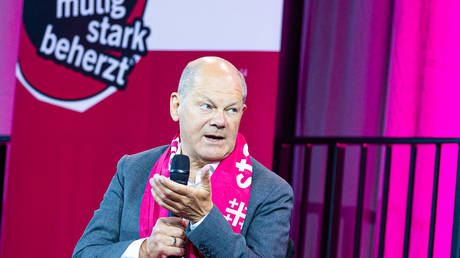 ‘Don’t rush’ to ban AfD – Scholz
‘Don’t rush’ to ban AfD – Scholz
He argued that the “AfD is the most popular party in Germany, and by far the most representative of East Germany” – an assertion that appears to be borne out by election results in the economically underdeveloped regions of former East Germany in recent years.
During the Munich Security Conference in February, Vance chastised politicians who shun parties such as the AfD, which is known for its tough anti-immigration stance.
On Friday, the German domestic security service (BfV) announced the decision to officially designate AfD a “confirmed extremist entity” – a status that grants the authorities the unrestricted right to surveil the party’s activities.
The agency cited the “extremist nature of the entire party, which disregards human dignity” as well as the AfD’s “prevailing understanding of the people based on ethnicity and descent.” The latter is said to be “incompatible with the democratic basic order.”
The party came in second in the snap election in February, behind the center-right Christian Democrats, which ruled out any coalitions with the AfD, as did all the other major parties. Recent polls show the two parties neck-and-neck, with one survey by the Forsa Institute putting the AfD one percentage point ahead of the Christian Democrats.
-
Site: RT - News
The billionaire has accused the “legacy media” of waging a propaganda campaign against him and trying to portray him as a Nazi
US government efficiency chief and tech billionaire Elon Musk has accused the American “legacy media” of waging a concentrated “character assassination” effort against him, claiming they would have “immediately” killed him “in reality” if offered such an opportunity.
The Space X and Tesla CEO made the remarks on Saturday in an interview with Lara Trump, a Fox host and the US president’s daughter-in-law, during which he reflected on the fallout of his speech at the inauguration of Donald Trump back in January.
During the event, Musk made gestures that were perceived by some as Nazi salutes. The billionaire, however, continues to insist that his actions were deliberately misrepresented by the mainstream media and had nothing to do with Nazi gestures.
“Obviously, I’ve not harmed anyone in my life, so it’s an outrageous thing to claim that I’m a Nazi,” he claimed. “If you repeat a lie, you know, the sort of ‘he’s a Nazi lie’ enough times, some people actually believe it, especially people that still believe the legacy news, you know.”
Propaganda works because people want simple narratives. But the truth is messier, and it’s worth fighting for. I’m not here to play their game. I’m here to build a better future, no matter how many lies they throw my way.
The main “issue” with the Nazis was not their “mannerisms” or their “choice of dress,” but the “fact that they killed millions of people,” Musk argued.
Read more Most Americans disapprove of Musk’s DOGE performance – poll
Most Americans disapprove of Musk’s DOGE performance – poll
The billionaire also defended the US president, stating that Trump has been the target of a similar “propaganda” campaign for over 20 years already. The US leader is “not a violent person,” Musk said, and “in fact has done a lot to prevent wars and stop wars, which is the very opposite of being a Nazi.”
Musk claimed that the media’s hatred of him is very personal and that his critics would not hesitate to assassinate him if presented with such an opportunity. He did not elaborate on who exactly he suspected of being capable of a such an act.
“They’re trying every angle to get me. If they could press a button and kill me in reality, they’d press it immediately. But since I’m a little hard to kill, they’re resorting to character assassination instead,” he claimed.
-
Site: RT - News
The billionaire has accused the “legacy media” of waging a propaganda campaign against him and trying to portray him as a Nazi
US government efficiency chief and tech billionaire Elon Musk has accused the American “legacy media” of waging a concentrated “character assassination” effort against him, claiming they would have “immediately” killed him “in reality” if offered such an opportunity.
The Space X and Tesla CEO made the remarks on Saturday in an interview with Lara Trump, a Fox host and the US president’s daughter-in-law, during which he reflected on the fallout of his speech at the inauguration of Donald Trump back in January.
During the event, Musk made gestures that were perceived by some as Nazi salutes. The billionaire, however, continues to insist that his actions were deliberately misrepresented by the mainstream media and had nothing to do with Nazi gestures.
“Obviously, I’ve not harmed anyone in my life, so it’s an outrageous thing to claim that I’m a Nazi,” he claimed. “If you repeat a lie, you know, the sort of ‘he’s a Nazi lie’ enough times, some people actually believe it, especially people that still believe the legacy news, you know.”
Propaganda works because people want simple narratives. But the truth is messier, and it’s worth fighting for. I’m not here to play their game. I’m here to build a better future, no matter how many lies they throw my way.
The main “issue” with the Nazis was not their “mannerisms” or their “choice of dress,” but the “fact that they killed millions of people,” Musk argued.
Read more Most Americans disapprove of Musk’s DOGE performance – poll
Most Americans disapprove of Musk’s DOGE performance – poll
The billionaire also defended the US president, stating that Trump has been the target of a similar “propaganda” campaign for over 20 years already. The US leader is “not a violent person,” Musk said, and “in fact has done a lot to prevent wars and stop wars, which is the very opposite of being a Nazi.”
Musk claimed that the media’s hatred of him is very personal and that his critics would not hesitate to assassinate him if presented with such an opportunity. He did not elaborate on who exactly he suspected of being capable of a such an act.
“They’re trying every angle to get me. If they could press a button and kill me in reality, they’d press it immediately. But since I’m a little hard to kill, they’re resorting to character assassination instead,” he claimed.
-
Site: RT - News
The US envoy to the bloc has reportedly warned European member states of a potential boycott by the US president unless they agree to increase defense spending
US President Donald Trump could snub NATO’s upcoming summit unless European member states commit to significantly higher defense spending, Germany’s Der Spiegel reported on Friday.
US Ambassador to NATO Matthew Whitaker has repeatedly demanded that European member states shell out 5% of their GDP on defense, as opposed to the military bloc’s previous target of 2%, according to the outlet, citing “confidential reports” from German officials in Brussels. Whitaker reportedly warned that failure to meet the new benchmark could result in Trump declining to attend NATO’s summit in The Hague scheduled for late June.
Der Spiegel noted that during a phone call with German Defense Minister Boris Pistorius last month, US Secretary of Defense Pete Hegseth “conveyed the administration’s intent for European allies to assume primary responsibility for Europe’s conventional defenses,” and urged his counterpart to “actualize defense spending increases,” as reported in a readout published by the Pentagon.
In an interview with The Free Press last week, Secretary of State Marco Rubio described the current arrangement within the military bloc as the US and a “bunch of junior partners that aren’t doing their fair share.”
Read more Trump adviser explains why US must cut military aid to Europe
Trump adviser explains why US must cut military aid to Europe
Hegseth has echoed the sentiment, proclaiming that the “time of the United States… being the sole guarantor of European security has passed. It’s long overdue Europe has to step up, fund its military, and lead.” He similarly stated that NATO’s current 2% defense spending target is insufficient.
Last month, Trump said he would not rule out withdrawing some or all of the 84,000 US troops currently stationed in Europe since Washington foots the bill for the continent’s security, while not getting “reimbursed by much.”
As of 2024, 23 of the 32 NATO member countries had reached the 2% benchmark set in 2014, according to the bloc’s own estimates cited by the BBC. The US currently spends around 3.5% of its GDP on defense and is NATO’s biggest overall contributor.
-
Site: OnePeterFive

Your Eminences: The following document emerged from discussions over the past year among theologians, pastors, and canonists, who had been encouraged to produce this document by a senior cardinal. Originally our thought had been to seek for signatories—knowing, as we do, how many notable figures in the Catholic Church are in agreement with or sympathetic to the points made herein—but in view…
-
Site: Zero HedgeIs This The Man Who Created COVID-19 In Fauci's US Lab?Tyler Durden Sat, 05/03/2025 - 15:10
Authored by Will Jones via The Brownstone Institute,
Top US virologist Ralph Baric engineered the Covid-19 virus SARS-CoV-2 in his lab at the University of North Carolina as part of his work in connection with the 2018 DEFUSE funding proposal. That’s the story that’s been going round the internet for some months now (and not just in alternative media) and it all looks very damning for Baric and those connected with his research.
Details of the DEFUSE project were first leaked by Major Joseph Murphy, an employee of US military research agency DARPA, in the summer of 2021 and further details of earlier drafts have come to light this month thanks to public record requests from U.S. Right to Know (USRTK).
In DEFUSE, Baric proposed to create a virus that was, to most intents and purposes, SARS-CoV-2. The proposal included inserting a furin cleavage site into a coronavirus spike protein, an order for the restrictive enzyme BsmBI, the search for a binding domain that would infect ACE2 human receptors and a requirement for a viral genome around 25% different to SARS.
The SARS-CoV-2 virus contains a furin cleavage site in its spike protein, its genome includes the restrictive enzyme BsmBI, it has a receptor binding domain finely tuned to infect the ACE2 human receptor and its genome is around 25% different to SARS. A number of virologists have said that such features make SARS-CoV-2 a smoking gun for an engineered virus.
Baric obtained a patent for such novel viruses in 2018, just as he was putting DEFUSE together. In DEFUSE he proposed to infect wild Chinese bats with his newly patented viruses.
Many regard this as case closed for the lab leak.
But this is not the full story. That’s because Baric’s DEFUSE proposal did not win the DARPA funding.
And while it is rightly pointed out that, with or without the funding, much of the work was already in hand, it’s what happened next with the winning DARPA proposal where the story really gets interesting.
US researcher Jim Haslam has done an incredible job on his Substack article Reverse engineering the origins of SARS-CoV-2 documenting all the toings and froings among the virology community in connection with the creation of this peculiar virus and the subsequent cover-up. What follows is in large part indebted to his meticulous research, though any errors are of course my own.
The winning 2018 DARPA bid was for a project called PREEMPT led by Dr. Vincent Munster (pictured above) based at Anthony Fauci’s NIH Rocky Mountain Lab. Both PREEMPT and Baric’s losing DEFUSE project had the same basic idea: to try to prevent a (hypothetical) future pandemic by using an engineered SARS virus to vaccinate the bats from which it is believed such a virus was likely to spill over.
The idea being, of course, that the vaccinated bats would no longer be a reservoir for the virus, thus ‘defusing’ or ‘preempting’ the zoonotic spillover. Sounds crazy? Too right – far too much meddling with nature and placing too much faith in the ability of vaccines to prevent infection and transmission. But crazy or not, that’s what the scientists proposed, and PREEMPT won and DEFUSE lost.
The key difference between Baric’s DEFUSE and Munster’s PREEMPT – aside from PREEMPT coming in around $4 million cheaper at $10 million – is that rather than relying on spraying bat caves with a non-transmissible virus-vaccine, Munster’s plan involved making the virus-vaccine transmit between the bats via aerosols. This made it a self-spreading vaccine, able (in theory) to reach all the bats without humans having to go and find all their caves and spray them. The risks of such a plan should have been obvious. Indeed, Baric himself, who went awfully quiet after his DEFUSE project leaked in mid-2021, resurfaced in mid-2023 to say that such work involving engineering transmissible virus-vaccines was “too edgy” for him.
After the DARPA funding went to PREEMPT, Fauci rode to Baric’s rescue with a bumper $82 million programme called CREID, awarded in summer 2019, in which both Baric and Munster’s teams would cooperate in the research into Munster’s concept of self-spreading bat vaccines.
Exactly what happened next is not publicly documented, so we do need to fill in some gaps.
It appears that Munster took Baric’s patented SARS virus-vaccine and made a transmissible version at his Rocky Mountain Lab (Baric’s version was not intended to be transmissible). What is the evidence for that? Perhaps most telling is that, as Haslam observes, SARS-CoV-2 transmits efficiently in only five known mammals, and those five – American deer, American deer mice, Syrian hamsters, American mink, and Egyptian fruit bats – are all found in Munster (and Fauci’s) Rocky Mountain Lab in Montana. SARS-CoV-2 doesn’t infect lab animals common in Chinese labs or present in the WIV, such as Chinese horseshoe bats. This would suggest that SARS-CoV-2 acquired its transmissibility in an American lab context and not a Chinese one or elsewhere.
The virus-vaccine having been made transmissible in Montana, it would then have been sent to the WIV to be tested on Chinese bats, which were not available in American labs. There can be little doubt who would have done this testing at the WIV, as there was only one scientist with the necessary connections and expertise.
Dr. Danielle Anderson, known as Dani to her colleagues, gained fame in June 2021 as the “last and only foreign scientist in the Wuhan lab” as she went public to make the case for a zoonotic origin. Dani was a member of the Lancet origins commission, chaired by Jeffrey Sachs and disbanded by him in October 2021 over frustrations that the Western virologists like Dani weren’t cooperating. Dani was based on and off at the WIV in the high security BSL4 lab (not Shi Zhengli’s BSL2 lab), but she didn’t work for the WIV. She worked for Duke-NUS, the Singapore-based medical school of North Carolina’s Duke University, under the virologist Dr. Linfa Wang. Linfa and Anderson were part of Baric’s DEFUSE proposal, and Duke-NUS was later a partner in Fauci’s CREID project.
Anderson’s role in DEFUSE was to test the virus-vaccines on “wild-caught captive” Chinese horseshoe bats at the WIV. It is thus reasonable to assume it is her who would be responsible for testing Munster’s self-spreading virus-vaccine on the same Chinese bats. This would explain how the virus got to Wuhan.
It would explain, in other words, how a non-transmissible virus-vaccine designed by Ralph Baric at UNC as per the DEFUSE proposal became a transmissible virus and ended up on the loose in Wuhan. Namely, because it escaped via a laboratory-acquired infection during Anderson’s testing of it on Chinese horseshoe bats in her WIV BSL4 lab, with Dani herself or a colleague as patient zero.
Admittedly, we don’t have direct evidence of this – we don’t have direct evidence that a Munster-Baric SARS-2 virus-vaccine was being tested on Chinese bats in the WIV in 2019, nor that Dr. Anderson or a colleague was infected by it in the lab. But there is a heap of evidence that points to it as a likely scenario.
We know, for instance, that both Baric and Munster were proposing to vaccinate Chinese bats using an engineered virus based on SARS, with a furin cleavage site inserted to increase infectivity. We know that Munster’s PREEMPT proposal, in which the virus-vaccine was to be self-spreading, won the DARPA funding, beating Baric’s DEFUSE proposal for a non-self-spreading virus-vaccine, and that in 2019 both teams were brought together in an $82 million grant from Fauci’s NIAID.
We know that SARS-CoV-2 readily transmits in the lab animals found in Munster’s Rocky Mountain Lab but not in the lab animals found in the WIV. From this we can further conclude that Dr. Anderson’s experiment to infect Chinese horseshoe bats with the new virus at the WIV presumably failed. This may be why she left Wuhan at the end of November, which was the deadline for the ‘scientific merit review’ for CREID.
We also know that where Dani and her colleagues lived in central Wuhan was an early epicentre for the SARS-CoV-2 outbreak, based on social media data.
It also appears that Dani’s supervisor Linfa Wang may have quickly realised that SARS-CoV-2 was one of his viruses. This would explain why he resigned from his post as Director of Duke’s Emerging Infectious Disease programme, a position he had held for nearly a decade, on the same day that the genome was published, January 10th 2020. The reason for his abrupt resignation has never been disclosed.
Four days earlier he had told the New York Times he was frustrated that scientists in China were not allowed to speak to him about the outbreak. He cautioned against panic, arguing the virus was likely not spreading between humans because health workers had not contracted the disease. But privately was he fretting that it was from his lab – is that why he immediately resigned when the genome was published? It is hard to understand what else could have led him to quit so suddenly at that point, and the lack of explanation adds to the suspicion. He later called January 10th “the most important day in the Covid-19 outbreak” because it was when the genome was published.
If Linfa was anticipating the bad news, it could have been because he and Dani had been aware of the leak at the time it happened. Analysis of mobile phone records discovered an apparent shutdown of Dr. Anderson’s BSL4 lab between October 7th and 24th 2019 (identified by the lack of mobile phone usage in the vicinity). Nothing further has come to light about this incident and what lay behind it, but if it does denote a laboratory-acquired infection that Anderson and Linfa (and presumably others) were aware of, it would explain a lot.
Such a scenario would also explain why Shi Zhengli had been eager to publish the sequence for the RaTG13 virus she held (the preprint appeared on January 23rd 2020), despite this suggesting to many a non-natural origin of SARS-CoV-2. In the paper, the WIV scientist implied that SARS-CoV-2 had not emerged naturally from RaTG13, despite it being the closest known virus (“no evidence for recombination events was detected in the genome”). Publishing it showed that her (BSL2) lab had nothing to hide as it was not involved in the work. The realisation that it was an engineered virus from the US may also have driven the panic that pushed the Chinese Government to lock Wuhan down around the same time.
Since 2021, Ralph Baric has thrown himself into developing vaccines for SARS-CoV-2 and other coronaviruses, even entertaining fantasies of “ring vaccination,” as is done with Ebola, to try to stop the outbreak in its tracks.
Is this his way of trying to make amends, however misguided?
I wonder if we are also able to detect a hint of him pointing to who he thinks is really to blame for the debacle, when he remarks that “governments, rather than scientists” are primarily responsible for choosing which risky gain-of-function experiments to fund and run – a reference perhaps to how Munster’s “edgy” engineering of transmissible virus-vaccines was picked over his non-transmissible version.
“It looks like American science is going to get shredded for a pandemic that started in China,” he told Time‘s Dan Werb, reverting to denial. When Werb suggested to him that despite the “conspiracy theories” there are many people happy that he became a scientist in the first place, he replied:
“A fair number that probably wished I hadn’t. Let’s be honest.”
Is that the closest we’ll get to a confession?
Republished from The Daily Sceptic
Views expressed in this article are opinions of the author and do not necessarily reflect the views of ZeroHedge.
-
Site: Henrymakow.com

"It helps to see heterosexual love as a mystical dance. The male leads; the female follows."
Humanity suffers from a phenomenon I call "transference." This is when we seek our ideal by seeking perfection in someone else ("love") instead of ourselves. This emasculates men. We only need to answer the Divine Spark in our soul.
Our natural state is Bliss. The reason we are so restless and miserable is that we seek to regain this bliss from society (sex, "love," status, money, power etc.) instead of from our own soul-connection to God. The Kingdom of Heaven is within!
Another example of transference is when we blame God for our own failures. God depends on us to fulfill His Design.
Heterosexuality is not based on "equality." It is based on unequal Power.
Masculinity is defined by Power. Femininity is defined by Love. Men want power. Women want love. Heterosexual marriage is an exchange - female power for male power expressed as love. A woman shows her love by entrusting her power to a man who has won her trust through courtship. This is feminine.
When men surrender power, they are emasculated. This article, my first on the Internet 23 years ago, describes how I learned to follow my masculine instincts.

The male is dominant in a heterosexual relationship.
The Cabalists (Satanists) have neutered both sexes by teaching women
to seek power instead of love. They are tampering with the fundamental laws of the universe (yin active-yang passive.)
Men are hardwired to love and protect women. Feminism has deprived women of the greatest treasure life has to offer.
Updated from 2003 and 2024
By Henry Makow PhD
When I was 21 years old, and living in Israel, I received a letter from my mother. She had taken my savings and invested in a townhouse.
"Now, you are a mensch," she said.
I wondered what she meant. How did owning a house make me "a man?"
I came of age at a time when youth was "looking for an identity." I was searching for it in Israel. Later, I became a Canadian nationalist. In each case, I didn't find identity in "community."
I had a strong patriarchal father, an excellent role model. He built a successful career and supported a family.
"Find work you enjoy," he would tell me. "Work is the backbone of a man. It's the most important decision a man makes. A wife is the second."
But for some reason, his example didn't register. Why not?
For centuries, men defined themselves in terms of masculinity. Why was I so clueless?
I took my cues from the mass media. I was a feminist.
ATTACK ON GENDER AND FAMILY
I grew up in an era that bought the feminist lie - men and women are identical. In our culture, women are encouraged to be "equal" -- do everything men do, and vice versa. "Equal" became "identical." This retarded my personal development by 25 years. I doubt if I am alone.
"Identical" made me look for myself in a mate. I was literally attracted to lithe young women with cropped boyish haircuts: my own persona.

I put a woman on a pedestal because she had the key to my identity. She could give it back to me. Some women were immediately repelled. Others enjoyed the adulation for a while but eventually lost respect.
What I needed was someone quite different from me, my feminine complement.
Eventually, feminism will be recognized for what it is: a virulently anti-social, anti-women, lesbian ideology that achieved power by pretending to champion "women's rights." By taking power, feminism has been able to emasculate men and masculinize women. In other words, women have usurped the masculine identity, and in the process, both sexes have lost their own.
Incredibly, the destruction of heterosexuality is the hidden agenda of feminists, who think gender difference is the source of all injustice.
Most people don't realize that the feminist movement literally is Communist in origin. Most of the leading feminist thinkers, including Betty Friedan and Simone de Beauvoir, were Marxists, and many also were lesbians.
Feminism is about power, not a choice. "No women should be authorized to stay at home and raise her children," said feminist founder Simone de Beauvoir. "Women should not have that choice, because if there is such a choice, too many women will make that one" (Saturday Review, June 14, 1975).
If feminism were really about choices, it would not indoctrinate women to enter the workforce and become "independent." It would not demonize men and heterosexual love. It would not ostracize feminists who marry and start families.
Lesbians have always been women who coveted the male role. It is based on Marxist notions of "equality" and class conflict that have no relevance to a mystical and biological reality such as love.
The breakdown in the traditional family caused by feminism is the main reason for our social, personal and existential problems. People have always derived meaning and purpose from familial roles (e.g. daughter, wife, and mother) and from life-cycle rituals, (marriage, birth and death). Indeed, marriage and family are a God-given path to achieve love and personal fulfilment.
We do not find wholeness by incorporating masculine and feminine in ourselves but by uniting with our opposite. Heterosexual love is the attraction of opposites. Indeed, as heterosexuals, we define ourselves in terms of these differences. If we are male, we are not female, and vice-versa, like dark and light. Because I denied these differences, I didn't know who I was. I didn't understand women, and I didn't know how to approach them.

RECLAIMING MASCULINITY
I was almost 50-years-old before I solved the riddle. A book The Flight from Woman (1964) by Karl Stern, a Canadian psychiatrist, confirmed what my instincts were saying. My mother had been right all along. A man makes the house; the woman makes the home.
According to Stern, masculinity is defined by "power" over the natural and social environment. Men provide the physical and cultural context for the domestic world. They are do'ers: adventurers and builders, protectors and providers.
Femininity is defined by "love." Feminine psychology is founded on nurturing and loving husbands and children, and thereby being needed and loved. Women are the engines of love, acting much like the heart in the body. The family is the fundamental building block of society and foundry of the future. Women are its foundation.
Men define themselves by deeds; women simply are love: beauty, grace, faith and goodness. Men tend to be rational and objective; women subjective, intuitive and emotional. Distinctions like these need not constrict us. They are a theme upon which to play our own variations. For example, my wife mows the lawn; I do all the shopping and cooking. But without the theme, there is confusion and chaos.
The feminist gospel that traditional sex roles are "oppressive" is wrong. For many people, a flexible interpretation of traditional roles are essential for happiness and fulfilment.
I extrapolated from Karl Stern's distinctions. If man is motivated by power and woman by love, heterosexual love must be an exchange of the two.
A woman surrenders her power, in trust. This is how a woman expresses her love. By trusting. In this way, women actually empower men. If a man betrays this trust, he loses his power.
In return for her power, a woman gets what she really wants: a man's power expressed as his intense, undivided love.
He includes her in his sphere of self-interest: this is how two people become one. Her happiness is his happiness. He can't hurt her without hurting himself.
RECLAIMING FEMININITY
Teaching women to seek masculine power prevents them from getting what they really want. Women want to be possessed by a man's love.
God's love of Creation is mirrored in a man's love of a woman. A man channels God's love to a woman by making her a wife and mother. Women want masculine power, but it must be in a man.
A girlfriend once told me, "I want to be used." The same girlfriend also said that without a man, she feels "like a rudderless boat." Similarly, a man without a woman is a rudder without a boat.
A man cannot love a woman who is competing with him for power. Relationships between so-called "equals" are like mergers, or roommates.
Psychiatrist, Irene Claremont de Castillejo, calls them "brother-sister" marriages (Knowing Women: A Feminine Psychology, 1973).
They cannot achieve the intimacy as when a woman surrenders her will to a man, and a man returns this trust with his wholehearted love. Some psychiatrists say a woman's sexual satisfaction is also linked to her ability to trust and surrender.
Heterosexuality is not based on "equality." Women empower men by surrendering to them in exchange for love.
Femininity is based on the surrender of power for love. When men do it, they are emasculated.
Feminine women are creatures of God. In love, they sacrifice their "selves" for love, which in many religions is the key to transcendence. Helen Deutsch remarked on this"masochist-narcissist" syndrome (sacrifice for love) in her The Psychology of Women: A Psychoanalytic Interpretation (1944). The majority of women only achieve fulfilment as wives and mothers. In their hearts, they know it.
Nor can women love men with whom they compete. Women are hypergamous which means they seek men of higher status than themselves. Even the most ardent heterosexual feminist only can love someone more powerful than she.
The struggle for power is poisoning male-female relations. It is the death of love. Men cannot give up their defining characteristic (power) and expect to be men. Women cannot criticize and challenge men and expect to be loved.
When I comprehended this, I felt liberated. I established a healthy relationship with a woman who is my female complement and married her.
CONCLUSION
The universal complaint is that men don't know how to be men; women don't know how to be women. It helps to see heterosexual love as a mystical dance. The male leads; the female follows. You can't have a graceful dance without each partner playing his part.
The dance is based on love. The male is always considering his mate's wishes because he loves her. In some cases, he will ask her to lead.
He has no desire to stifle or frustrate her. He wants her to thrive because she is part of him.
As in a ballroom dance, who can say which role is more important? Both partners are of equal value. The dance requires both the leadership and dynamism of the male; and the beauty, love and grace of the female.
In the dance of love, two people become one, and the fruit of this mystical union is often a child.
--------
Related - 50 Real Difference Between Men and Women
First Comment from Zahra:
I am a young girl of fifteen in England and I am very glad to have come across your website. It is a very informative read. I especially enjoy your articles on feminism. What I like about your website compared to other websites is the fact you don't demonize women or reduce them to sex and beauty the way others do. I feel...safe reading your things. You really ought to sell your ideas to schools (if you don't get arrested though!). I am feeling conflicted; I want to study medicine when I'm older and find a cure for diseases but I also want to have children one day. Marriage won't be as much of a problem since I'd be getting an arranged marriage when I'm around twenty. I'm a second generation immigrant child whose parents spent their formative years in the UK so you'd have thought they'd at least understand the culture clash I'm going through. They don't but never mind. I was wondering what you might do in my situation.
Zahra
Do you have the option of having your family first and then training afterwards? If you do, that is the path I'd recommend.
Henry
-
Site: Zero HedgeFBI Reportedly Places Infamous Censorship Agent On 'Terminal Leave'Tyler Durden Sat, 05/03/2025 - 14:44
Elvis Chan, the FBI’s Assistant Special Agent in Charge in San Francisco, has reportedly been placed on “terminal leave” and has not accessed agency systems for over a month, according to independent journalist Breanna Morello.
Chan has faced scrutiny for his alleged role in coordinating with social media platforms, including X (formerly Twitter), to censor conservatives during the 2020 presidential election, which saw President Joe Biden defeat President Donald Trump. In September 2023, House Judiciary Committee Chairman Jim Jordan (R-OH) issued a subpoena compelling Chan to testify about the FBI’s interactions with tech companies, which Jordan described as potential “coercion and collusion” to censor speech, according to the New York Post.
Chan, who served as a liaison to companies like Facebook and Twitter through the FBI’s Foreign Influence Task Force, did not attend a scheduled interview with the committee, prompting the subpoena, Jordan said, per the Post.
During a 2023 deposition with attorneys general from Louisiana and Missouri, Chan denied having “internal knowledge” of efforts to suppress a 2020 New York Post story about Hunter Biden’s laptop.
Morello notes:
The controversy surrounding Chan coincides with a 2023 ruling by the U.S. Fifth Circuit Court of Appeals, which found that the FBI, White House, U.S. Surgeon General, CDC, and CISA likely violated First Amendment rights by “coercing or significantly encouraging” social media platforms to censor content.
...
Chan, who identifies with “he/him” pronouns on his LinkedIn profile, still lists himself as the Assistant Special Agent in Charge at the FBI’s San Francisco Bay office, where he has served for over 19 years.
The FBI has not commented on Morello’s report.
The allegations against Chan come amid broader efforts by the Trump administration to protect free speech. In January, President Donald Trump signed an executive order prohibiting federal agencies from labeling citizen speech as “misinformation” or “disinformation.” Addressing the World Economic Forum, Trump said the order aimed to “safeguard free speech” and halt practices that “stifle the exchange of ideas.”
Last month, Secretary of State Marco Rubio announced the closure of the Global Engagement Center, a State Department entity criticized for its role in monitoring online speech. In an op-ed published in The Federalist, Rubio cited a 2020 GEC report that flagged speculation about COVID-19’s origins, including theories about a Wuhan lab, as part of a “Russian disinformation” campaign.
"Finally, as we recommit this country to its core constitutional free speech principles at home, we will remain vigilant abroad — not just against threats from adversaries such as Communist China but also from less expected countries where authoritarian censorship is gradually strangling true freedom of speech," Rubio added. "We are not afraid. At her birth, America was a lone beacon of freedom to the world. If necessary, we will happily be that lone beacon once again." -
Site: RT - News
The country’s ambassador to Russia has told RT he hopes for a “deescalation of tensions” with India amid concerns over possible military action
Pakistan will respond with the “full spectrum of power” if India attacks it or disrupts vital water flows, the country’s ambassador to Russia, Muhammad Khalid Jamali, has said as tensions remain escalated between the two nuclear-armed neighbors following a deadly attack against civilians in Kashmir.
Speaking to RT on Saturday, the ambassador said that Pakistani intelligence has evidence of planned military aggression from New Delhi, which has accused Islamabad of supporting cross-border terrorism on its soil. “There are some other leaked documents whereby it has been decided to strike certain areas of Pakistan,” Jamali said. “So that makes us feel that this is going to happen and it’s imminent.”
The ambassador warned that Pakistan is prepared to respond to any aggression: “We in Pakistan will use the full spectrum of power, both conventional and nuclear.”
He also reiterated Islamabad’s position regarding the Indus Water Treaty, a key agreement between India and Pakistan, which New Delhi suspended last week as a part of its diplomatic response to the attack. “Any attempt to usurp the water of the lower riparian, or to stop it, or to divert it would be an act of war against Pakistan and would be responded to with full force of power including full spectrum of power,” the envoy said.
Read more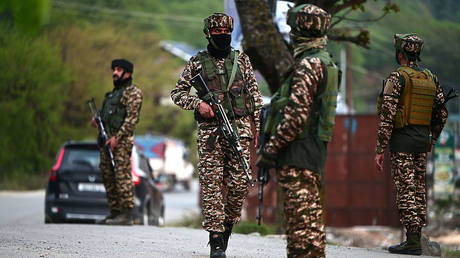 Pakistan claims Indian attack is ‘imminent’ – Reuters
Pakistan claims Indian attack is ‘imminent’ – Reuters
Jamali, however, urged de-escalation, noting the potential danger given that both countries possess nuclear weapons. “As the two countries are two nuclear powers, there is all the more need to deescalate the tensions.” Pakistan has earlier called for “neutral and credible investigations” into the Kashmir attack. “I think the role of the international community comes in. And in this regard, we expect that powers like China and Russia can participate in those investigations,” he added.
New Delhi earlier reduced the staff at the Pakistani High Commission, expelling Pakistani diplomats, and closing its land border – and Islamabad responded with reciprocal measures. The Indian government also suspended visa services for Pakistani nationals. On Saturday, New Delhi announced a set of further measures aimed at downgrading already severed trade ties with Pakistan.
READ MORE: ‘Our hearts bleed today’: How terrorist attack shook fragile stability in Kashmir
The terrorist attack occurred in the afternoon of April 22 in Baisaran Valley, a popular tourist destination around 6km from the town of Pahalgam. The Resistance Front, a militant group believed to be linked to the Pakistani-based Lashkar-e-Taiba, has reportedly claimed responsibility, prompting New Delhi to accuse Islamabad of supporting cross-border terrorism. Police in Kashmir say they have identified three suspects, two of whom are Pakistani nationals, in the attack.
-
Site: RT - News
The country’s ambassador to Russia has told RT he hopes for a “deescalation of tensions” with India amid concerns over possible military action
Pakistan will respond with the “full spectrum of power” if India attacks it or disrupts vital water flows, the country’s ambassador to Russia, Muhammad Khalid Jamali, has said as tensions remain escalated between the two nuclear-armed neighbors following a deadly attack against civilians in Kashmir.
Speaking to RT on Saturday, the ambassador said that Pakistani intelligence has evidence of planned military aggression from New Delhi, which has accused Islamabad of supporting cross-border terrorism on its soil. “There are some other leaked documents whereby it has been decided to strike certain areas of Pakistan,” Jamali said. “So that makes us feel that this is going to happen and it’s imminent.”
The ambassador warned that Pakistan is prepared to respond to any aggression: “We in Pakistan will use the full spectrum of power, both conventional and nuclear.”
He also reiterated Islamabad’s position regarding the Indus Water Treaty, a key agreement between India and Pakistan, which New Delhi suspended last week as a part of its diplomatic response to the attack. “Any attempt to usurp the water of the lower riparian, or to stop it, or to divert it would be an act of war against Pakistan and would be responded to with full force of power including full spectrum of power,” the envoy said.
Read more Pakistan claims Indian attack is ‘imminent’ – Reuters
Pakistan claims Indian attack is ‘imminent’ – Reuters
Jamali, however, urged de-escalation, noting the potential danger given that both countries possess nuclear weapons. “As the two countries are two nuclear powers, there is all the more need to deescalate the tensions.” Pakistan has earlier called for “neutral and credible investigations” into the Kashmir attack. “I think the role of the international community comes in. And in this regard, we expect that powers like China and Russia can participate in those investigations,” he added.
New Delhi earlier reduced the staff at the Pakistani High Commission, expelling Pakistani diplomats, and closing its land border – and Islamabad responded with reciprocal measures. The Indian government also suspended visa services for Pakistani nationals. On Saturday, New Delhi announced a set of further measures aimed at downgrading already severed trade ties with Pakistan.
READ MORE: ‘Our hearts bleed today’: How terrorist attack shook fragile stability in Kashmir
The terrorist attack occurred in the afternoon of April 22 in Baisaran Valley, a popular tourist destination around 6km from the town of Pahalgam. The Resistance Front, a militant group believed to be linked to the Pakistani-based Lashkar-e-Taiba, has reportedly claimed responsibility, prompting New Delhi to accuse Islamabad of supporting cross-border terrorism. Police in Kashmir say they have identified three suspects, two of whom are Pakistani nationals, in the attack.
-
Site: Zero HedgeFetterman Ex-Chief Of Staff Sounded Mental Health Alarm To Senator's DoctorTyler Durden Sat, 05/03/2025 - 14:35
Democratic Pennsylvania Senator John Fetterman's former chief of staff was so alarmed by his mental health last year that he sounded an alarm with the Walter Reed doctor who treated him during his lengthy in-patient stay for severe depression in 2023. Former aides who are in contact with Fetterman's shrinking inner circle say his behavior continues to cause periodic concern about his danger to himself and those around him.
“I’m worried that if John stays on his current trajectory he won’t be with us for much longer,” wrote Adam Jentleson in his 2024 email to Dr. David Williamson, neuropsychiatry chief at Walter Reed. Jentleson sent the email in May, weeks after he resigned from Fetterman's staff. In quitting, he became the fifth top aide to jump ship since Fetterman beat Trump-endorsed TV doctor Mehmet Oz in 2022.
 Fetterman with his wife Gisele, whom he nearly killed by falling asleep at the wheel last year
Fetterman with his wife Gisele, whom he nearly killed by falling asleep at the wheel last year
Jentleson's 1,600-word email, first reported by New York Magazine, referenced many warning signs that Fetterman's family and other close confidants had been told to watch out for:
“We often see the kind of warning signs we discussed. Conspiratorial thinking; megalomania (for example, he claims to be the most knowledgeable source on Israel and Gaza around but his sources are just what he reads in the news — he declines most briefings and never reads memos); high highs and low lows; long, rambling, repetitive and self centered monologues; lying in ways that are painfully, awkwardly obvious to everyone in the room.”
"We do not know if he is taking his meds, and his behavior frequently suggests he is not," wrote Jentleson, and a staffer told New York there have been days when aides would make sure nobody from outside the office came into contact with him -- days when he was in "some sort of state" where he could potentially say some "really fucked-up shit to constituents." In February, Fetterman was recorded being uncooperative with a pilot directing the overweight senator to either adhere to FAA rules requiring that one's fastened seatbelt is visible, or get off the plane:
Video from February—when John Fetterman got in an argument with a pilot about wearing his seatbelt so it was visible.
— Prem Thakker (@prem_thakker) May 2, 2025
“Sir if you want to go to Pittsburgh, it's simple: you have to follow our instructions or you're gonna be asked to get off the airplane.”
“We're not asking much.” pic.twitter.com/FQwMEcXBsDSources describe tension between Fetterman and his wife. "In March, Fetterman suddenly took an early-morning trip to Hartford, Connecticut, without telling his team why — leaving them at a loss for what to tell Gisele when she demanded to know why he was missing one of their kids’ birthdays," according to New York. Fetterman disputed the account, explaining he was visiting a grad-school friend's grave and claiming that his family and aides knew about it.
In his email last year, Jentleson also said Fetterman was avoiding his doctors: "He long ago ordered us to stop putting regular drop-bys with Dr. Monahan on his schedule, despite the fact that he had agreed to those as part of the plan." In group-texts from March 2024, staffers noted that the blood tests that were to be included in those appointments were "pillars of the recovery plan." Fetterman consultant Eric Stern wrote, "Is there any universe in which [his wife] Gisele could convince him to get his levels checked? I’m honestly just worried for him and don’t know who else could get through to him.”
Jentleson worried about Fetterman growing increasingly isolated, telling Williamson that “John has pushed out everyone who was supposed to help keep him on his recovery plan." He said the senator was spending hours gazing at this phone and composing tweets. Fetterman was said to have previously acknowledged that a preoccupation with social media was a principal "accelerant" of his depression.
"He engages in risky behavior," wrote Jentleson. "He drives recklessly: he FaceTimes, texts and reads entire news articles while driving — and I don’t mean while stopped at a light or something, he reads and FaceTimes while driving at high speeds." The warning about Fetterman's driving would soon prove prophetic -- almost fatally so. The next month, driving with his wife Gisele, Fetterman rammed his 2021 Chevy Traverse into the back of a car driven by a 61-year-old woman.
John Fetterman was found to be at fault for causing a major car crash in Western Maryland that totaled his SUV as well as the car of the woman he rear-ended. This guy's a total mess pic.twitter.com/Vd7DhuY8m5
— Michael Tracey (@mtracey) June 14, 2024“It’s a miracle no one died,” a police officer said. Both vehicles were totaled and all three people were hospitalized, with Gisele suffering a bruised lung and spinal fractures. Police Fetterman was going "well over" the 70 mph limit on I-70. Fetterman admitted to falling asleep at the wheel. His staff had worried about that very possibility, as Fetterman's accident happened after he took a red-eye flight from California where he appeared on Bill Maher's show. He ignored his aides' pleas to ask someone to pick him up at the airport and drive him.
Fetterman called the New York Magazine article a "hit piece" by two conspiring friends, Jentleson and writer Ben Terris, who "sourced anonymous, disgruntled staffers with lies or distorted half-truths," adding that “my ACTUAL doctors and my family affirmed that I’m very well.” His wife Gisele similarly accused Jentleson of lying.
Fetterman had a near-fatal stroke on May 13, 2022 -- four days before the Pennsylvania primary -- and was left with communications impairments that were painfully evident on those occasions where his campaign dared put him in front of cameras and microphones:
This is why Fetterman didn’t want to debate until after early voting was well under way
— Gummi (@gummibear737) October 26, 2022
It’s brutal and embarrassing to watchpic.twitter.com/cd5DoWwLeLHis depression hospitalization came just days after a lengthy and jarring New York Times profile that obliterated previous campaign assurances of Fetterman's fitness for Senate duty following his stroke. His treatment included medications, talk therapy and therapeutic walks at Walter Reed's rooftop healing garden. According to a discharge brief written by Williamson, Fetterman suffered “severe symptoms of depression with low energy and motivation, minimal speech, poor sleep, slowed thinking, slowed movement, feelings of guilt and worthlessness." He didn't have suicidal thoughts, according to the doctor.
 Mental health tip for the senator: To fend off feelings of worthlessness, don't dress like you're worthless (ABC News)
Mental health tip for the senator: To fend off feelings of worthlessness, don't dress like you're worthless (ABC News)
After taping a podcast inteview with Fetterman in April, The Bulwark's Tim Miller said Fetterman is "struggling. He’s, like, really struggling. And I just think coming off of the Biden thing, we should not be hiding the ball on this sort of stuff.” Of course, cynics have to wonder if leftist media's interest in illuminating the state of Fetterman's mental health has anything to do with his lean toward conservative stances, such as his backing of stricter immigration and border control.
After all, the Biden scandal showed that Democrats are all too happy to conceal major mental impairments up until the point they pose a risk to the leftist agenda.
-
Site: Ron Paul Institute - Featured Articles
The Washington Post is reporting today that recently-ousted National Security Advisor Mike Waltz may have been involved in activities even more nefarious than inviting journalists onto highly sensitive Signal group chats. It appears that what really angered President Trump is less Waltz’s incompetence (or worse) in keeping sensitive military communications secure, but rather his taking an active role in doing the bidding of a foreign government.
As the Post reported, in advance of Israeli Prime Minister Netanyahu’s February visit to the United States the US National Security Advisor to President Trump…
…appeared to have engaged in intense coordination with Netanyahu about military options against Iran ahead of an Oval Office meeting between the Israeli leader and Trump, the two people said.
That means that Mike Waltz was working with a foreign government to maneuver President Trump into a situation where war seemed the only option left to deal with Iran. That kind of manipulation is a classic neocon move and one that Waltz’s ideological allies managed with great success against President George W. Bush regarding Iraq.
According to one insider quoted in the article, Waltz, “wanted to take U.S. policy in a direction Trump wasn’t comfortable with because the US hadn’t attempted a diplomatic solution.”
That means the former NSA was working with a foreign leader to limit the diplomatic and military options his boss could choose from, i.e. he was working to hobble the United States so as to achieve an objective of a foreign regime.
The WaPo piece continues…
‘If Jim Baker was doing a side deal with the Saudis to subvert George H.W. Bush, you’d be fired,’ a Trump adviser said, referring to Bush’s secretary of state. ‘You can’t do that. You work for the president of your country, not a president of another country.’
To his credit, President Trump recognized that Waltz was blowing Bibi’s smoke at him and rather than bite at the trap sprung for him the President saw through the game and became annoyed possibly at both of them. The fiasco one month later, where Waltz claimed that neocon scribbler Jeffrey Goldberg’s contact information had somehow been “sucked up” into his phone and then presumably spit out again when it came time to invite top Administration officials onto a call to discuss military strikes on Yemen, may have been the straw that broke Trump’s waning patience in the man.
Last month, the Grayzone published leaked audio of Israel lobby AIPAC’s CEO, Elliott Brandt, “describing how his organization has cultivated influence with three top national security officials in the Trump administration – Secretary of State Marco Rubio, National Security Director Mike Waltz, and CIA Director John Ratcliffe – and how it believes it can gain ‘access’ to their internal discussions.”
Was the Waltz/Netanyahu trap for Trump the result of this “cultivated influence” that Brandt is bragging about? And if so, how much deeper does it go?
Whatever the case, it’s lucky for Waltz that he was “only” acting as an agent for our Greatest Ally ™ and Only Democracy in the Middle East ™. Otherwise he’d be soon enjoying the hospitality of Bukele’s All Male B&B rather than the rather more luxurious digs at 50 United Nations Plaza.
-
Site: OnePeterFive

The Mass developed organically from the night of the Last Supper until 1962, when the last Missal according to the Old Rite was published, although this statement must not obscure the fact that what took place that night itself already had a very ancient ritual history. During these two millennia, the extremely gradual changes that took place were only permitted if they aligned perfectly with the…
-
Site: Zero HedgeFAA Starts Probe After Two More Near-Misses With Army Helicopter At Washington Reagan AirportTyler Durden Sat, 05/03/2025 - 13:25
US federal investigators have launched a probe after two commercial flights were ordered to abort their landings at Reagan Washington National Airport on Thursday when a U.S. Army Black Hawk helicopter approached the area en route to the Pentagon Army Heliport.
The Federal Aviation Administration (FAA) said on May 2 that air traffic control told Delta Air Lines Flight 1671, an Airbus A319 that had originated in Orlando, and Republic Airways Flight 5825, an Embraer 170 that had departed from Boston, to perform go-arounds at around 2.30pm due to a priority military air transport helicopter in the vicinity.
The incident is under investigation by the FAA and the National Transportation Safety Board (NTSB).
The National Transportation Safety Board (NTSB) and the US Army are also investigating.
“While conducting flight operations into the Pentagon in accordance with published FAA flight routes and DCA Air Traffic Control, a UH-60 Black Hawk was directed by Pentagon Air Traffic Control to conduct a ‘go-around’, overflying the Pentagon helipad in accordance with approved flight procedures,” the US Army said in a statement.
“As a result, DCA Air Traffic Control issued a ‘go-around’ to two civil fixed wing aircraft to ensure the appropriate de-confliction of airspace.”
As Rudy Blalock reports for The Epoch Times, following a deadly mid-air collision on Jan. 29 involving an American Airlines regional jet and an Army Black Hawk helicopter, which resulted in 67 fatalities, the FAA has imposed permanent restrictions on non-essential helicopter operations around Reagan Washington National Airport.
The FAA told Congress it is reviewing the Army helicopter’s route in Thursday’s “loss of separation” incidents and is determining whether the route violated an agreement with the Army.
“It appears the Black Hawk operation did not proceed directly to the Pentagon Heliport. Instead it took a scenic route around the Pentagon versus proceeding directly from the west to the heliport,” the FAA said in a memo.
Delta Air Lines reported that Flight 1671 was carrying five crew members and 97 passengers.
“Nothing is more important at Delta than the safety of our customers and people. We’ll cooperate with the FAA as they investigate,” the airline said on Friday.
In separate statements to NTD News, Delta and Republic Airways said they are cooperating with the authorities investigating the incident.
The Pentagon did not respond to a request for comment by publication.
Sen. Maria Cantwell, the top Democrat on the Commerce Committee, criticized the fact that the same Army brigade flew a helicopter too close to Reagan Washington National Airport months after the fatal collision in January.
“It is outrageous that only three months after an Army Black Hawk helicopter tragically collided with a passenger jet, the same Army brigade again flew a helicopter too close to passenger jets on final approach at [the airport]. This comes less than a week after this brigade resumed flights in the National Capital Region. It is far past time for Secretary Hegseth and the FAA to give our airspace the security and safety attention it deserves,” she said in a statement.
The FAA in March permanently closed one key route and banned the use of two smaller runways at the airport when helicopters conducting urgent missions are operating near the airport.
The FAA is also investigating helicopter traffic near other major airports and recently announced changes to address safety concerns in other regions.
According to the NTSB, between October 2021 and December 2024, 85 recorded events at the airport involved a potentially dangerous near-miss between a helicopter and a plane, defined as a lateral separation of less than 1,500 feet and a vertical separation of less than 200 feet.
-
Site: Mises InstituteMurray Rothbard believed that the right to engage in voluntary exchange has long been understood as a natural right, not just a good, practical idea. Tariffs and other trade barriers violate that right.
-
Site: Mises InstituteWhen intellectuals and political elites call for equality, they usually mean creating social conditions that are make believe at best and harmful at worst. Their latest hustle is “equity,” which means the state should guarantee equal outcomes for everyone.
-
Site: AsiaNews.itThe Archbishop Emeritus of Bangkok has led the Thai Catholic Church with a focus on mission and inter-religious dialogue. He had promoted the foundation of the Thai Missionary Society - supported by PIME missionary Fr. Adriano Pelosin - closeness to the poor and openness to the Buddhist majority. He will be among the cardinal electors at the next Conclave.
-
Site: Zero HedgeA New Era: The ₿itcoin-Backed Monetary SystemTyler Durden Sat, 05/03/2025 - 12:50
Executive Summary
Since the collapse of Bretton Woods in 1971, the U.S. Dollar has functioned as a fiat currency. The petrodollar agreement in 1974 tied the Dollar indirectly to oil, reinforcing global demand for the Dollar. Today, with increasing skepticism toward fiat currencies and a rising interest in decentralized assets like Bitcoin, the U.S. could consider a new monetary system backed by Bitcoin as a digital, scarce, and decentralized asset. Bitcoin effectively delivers a more modern, automated and software-based approach to central banking.
This piece explores the viability of a Bitcoin-backed monetary system in the context of key historical financial developments, as well as the strategic path for its implementation.
The report concludes with an actionable strategy relevant to policymakers, financial institutions and investors.
-
July 1944 – The Bretton Woods Agreement: The Bretton Woods Conference established the U.S. Dollar as the world’s primary reserve currency, backed by gold. Under this system, the U.S. Dollar was pegged to gold at a fixed rate of $35 per ounce, while other major currencies were pegged to the U.S. Dollar. This agreement created a stable global monetary framework anchored by the U.S. Dollar’s convertibility into gold, and it laid the foundation for post-World War II economic growth.
-
August 1971 – Nixon Closes the Gold Window (“Nixon Shock”): President Nixon suspended the Dollar’s convertibility into gold. This marked the transition of the U.S. dollar from a gold-backed currency to a fiat currency whose value was determined by government decree rather than any fixed and independent asset.
-
October 1973 – The Oil Crisis and Price Shock: In response to U.S. and Western support for Israel, OPEC (led by Saudi Arabia) imposed an oil embargo on the U.S. and several Western nations. The embargo led to a severe shortage of oil, causing prices to quadruple from around $3 per barrel to $12 per barrel by early 1974. This sudden spike in energy costs triggered widespread inflation, economic disruption, and a global crisis that drove stagflation (simultaneously high inflation and high unemployment) in the Western economies.
-
June 1974 – The U.S.-Saudi Petrodollar Agreement: The U.S. and Saudi Arabia reached a pivotal agreement that laid the foundation for the petrodollar system, which later expanded to include other OPEC nations. The establishment of the petrodollar solidified the U.S. Dollar’s status as the world’s primary reserve currency, as the global demand for Dollars increased in conjunction with oil transactions. This arrangement also supported the growth of oil production worldwide and reduced OPEC’s strategic leverage, while providing the U.S. with a reliable source of foreign investment and demand for US government debt.
-
October 2008 – Release of the Bitcoin Whitepaper: In the wake of the global financial crisis and major bank failures, an anonymous inventor known as Satoshi Nakamoto published Bitcoin: A Peer-to-Peer Electronic Cash System. The paper described a transaction network requiring no third-party financial institutions or government intermediaries whatsoever.
-
March 2009 – The Federal Reserve Launches Quantitative Easing (QE): In response to the 2008 financial crisis, the Federal Reserve implemented its first round of Quantitative Easing (QE), purchasing U.S. Treasury bonds and mortgage-backed securities to inject liquidity into the financial system. This unprecedented monetary policy expanded the Fed’s balance sheet and marked the beginning of a prolonged period of U.S. Dollar debasement, fueling sustained asset price inflation.
-
December 2012 – The U.S. Debt-to-GDP Ratio Surpasses 100%: For the first time since World War II, the U.S. debt-to-GDP ratio exceeded 100%, signaling a shift to a highly leveraged fiscal position. This milestone underscored the growing reliance on debt-financed government spending and raised concerns about long-term fiscal sustainability.
-
April 2020 – The Fed Launches Aggressive Quantitative Easing Amid COVID-19 Pandemic: To counter the economic fallout from the COVID-19 pandemic, the Federal Reserve initiated a new round of aggressive QE, again expanding its balance sheet by purchasing Treasury bonds and mortgage-backed securities at an even greater scale. This increase in the money supply significantly debased the U.S. Dollar and drove a surge in asset prices, further exacerbating wealth inequality.
-
February 2022 – The U.S. Freezes Russia’s Foreign Currency Reserves and Weaponizes the U.S. Dollar: In response to Russia’s invasion of Ukraine, the U.S. and its allies imposed severe financial sanctions, freezing Russia’s foreign currency reserves held across Western banks. This action marked a turning point in global financial diplomacy, as it weaponized the U.S. Dollar and raised concerns among other nations about the risks of holding dollar-denominated reserves.
-
March 2022 – Shift Away from the U.S. Dollar in Global Oil Trade: Amid escalating geopolitical tensions, several oilproducing nations began entering bilateral agreements with their trading partners to settle oil transactions in currencies other than the U.S. Dollar. This signaled a potential erosion of the petrodollar system, as countries sought alternatives to reduce reliance on the U.S. Dollar in global trade.
-
June 2023 – Suspension of the U.S. Debt Ceiling: Congress eliminated the debt ceiling, removing the statutory limit on federal government borrowing. This decision effectively allowed unlimited borrowing, raising concerns about unchecked fiscal policy and the potential acceleration of U.S. debt growth, putting further pressure on the Dollar’s stability.
-
January 2024 – Bitcoin ETF Approved: The SEC approved the first spot Bitcoin ETF, paving the way for broader retail and institutional investment. This milestone legitimized Bitcoin, and the ETF wrapper provided easier access for investors, driving increased demand and significant capital inflows.
-
July 2024 – Trump Privately Refers to Bitcoin as “The New Oil”: In a private conversation leaked to the media (but not covered by the mainstream media), former President Donald Trump described Bitcoin as “the New Oil,” signaling a potential shift in U.S. policy toward digital assets. The statement suggests a recognition of Bitcoin’s growing role as a strategic asset in the global financial system.
-
November 5, 2024 – Donald Trump Wins U.S. Presidential Election: In a decisive and landslide electoral victory, Donald Trump is re-elected as President of the United States, with Republicans taking control of both the House and Senate. The election outcome marks a turning point for U.S. policy on digital assets and an end to unfettered regulatory hostility. The Trump administration commits to regulatory clarity, favorable tax policies, the establishment of a Strategic Bitcoin Reserve, and a framework that supports widespread digital asset adoption by individuals, institutions, corporations, pensions and governments.
-
November 8, 2024 – First Middle Eastern Crude Oil Transaction Using Tether Trade Finance: The world’s largest stablecoin firm, Tether, used its trade finance platform to complete its first funding of a crude oil transaction in the Middle East, settling in USDT. This groundbreaking deal appears to herald a major shift in global trade finance, showcasing the adoption of stablecoins as an alternative settlement mechanism for major commodity transactions outside of the traditional banking system.
The Future, and the Case for a Bitcoin-Backed U.S. Monetary System:
Under the petrodollar system, the U.S. effectively allowed the price of oil to rise (in Dollar terms), which increased global oil production and mitigated the strategic threat posed by OPEC. By creating a large, Dollar-denominated asset class (oil), the U.S. also established a mechanism to support the Dollar’s dominance abroad and finance its growing deficits at home. Surplus oil revenues from OPEC nations were recycled into U.S. Treasuries, reinforcing demand for the Dollar and giving the U.S. tremendous economic power globally.
Domestically, this system enabled politicians to engage in extensive borrowing and spending, driving U.S. debt from 36% of GDP in 1971 to ~125% today, a trajectory that now poses a serious challenge to the U.S. as a financial superpower, as well as its energy and national security.
Even at a ~$2 trillion market value, and with over ~$20 billion in average daily trading volume, Bitcoin is not yet large enough to replace the petrodollar as the backbone of the U.S. monetary system. However, a significant increase in Bitcoin’s price could catalyze a new paradigm.
Higher Bitcoin prices would likely drive substantial growth in U.S. Dollar-backed stablecoin issuance (due to the greater total market value of the asset class, and as the network effects of Bitcoin and digital asset transactions take hold);.
In turn, stablecoin issuance would directly boost demand for U.S. Treasury bills, effectively shifting the backstop of U.S. deficits from oil to Bitcoin.
This would allow the U.S. to maintain its monetary dominance while undermining the strategic power of the BRICS nations, who have turned to gold in an attempt to challenge and circumvent the Dollar system.
There are several recent developments that indicate the groundwork for this transition may already be underway.
The framework that follows is a preliminary outline of the potential steps towards a Bitcoin-Backed Monetary System.
The 21-Step Integration of Bitcoin into the U.S. Financial System:
Calculating the Required U.S. Ownership of Bitcoin:
When considering the transition to a Bitcoin-backed monetary system, M2 money supply provides the most comprehensive measure of U.S. Dollar liquidity in the economy. M2 includes not only cash and checking deposits (collectively defined as M1), but also savings accounts, money market funds, and other near-money assets.
This broader measure captures the full extent of Dollar-denominated assets that circulate and store value within the U.S. economy.
Key Assumptions:
-
Current U.S. M2 Money Supply: $22 trillion
-
Projected U.S. M2 Money Supply in 2045: $79 trillion (applying the 6.7% CAGR from 2000-2024)
-
Projected Bitcoin Price Target in 2045: $13 million (per Michael Saylor’s Bitcoin24 Model)
-
Capital Investment Today: Funded through partial monetization of official existing U.S. gold holdings (8,133 tonnes with a current market value of $764 billion); for simplification, assumes constant price of gold
-
Fully Diluted Bitcoin Supply: 21 million Bitcoin
-
Adjustment for Theoretical versus Actual Supply: It is estimated that 3 to 4 million Bitcoin may be lost or irretrievable, making the effective supply closer to 17 to 18 million Bitcoin. However, for simplicity and to maintain a conservative estimate, the maximum supply of 21 million Bitcoin is used
-
Below is a table showing the required U.S. ownership of Bitcoin for different levels of backing by 2045:
Bitcoin Backing Scenario Analysis
Note: Analysis is for illustrative purposes only; market data is as of 2/26/2025 and from publicly available sources.
Scenario Overviews:
1) 25% Backing
- This level of backing by the U.S. could serve as a hedge or partial reserve, similar to the role gold used to play in the early 20th century.
2) 50% Backing
- A 50% backing level implies a much more substantial reliance on Bitcoin within the U.S. monetary system. Increasing Bitcoin’s allocation not only accelerates its global adoption and reinforces its credibility as a reserve asset, but it also provides a meaningful hedge against escalating U.S. debt. With projections suggesting that the national debt could balloon to approximately $115 trillion by 2045 (based on extrapolation), a 50% backing could potentially offset up to 34% of that burden.
3) 100% Backing
-
Full backing would represent a Bitcoin standard, where the entire U.S. M2 money supply is backed by Bitcoin.
-
A full Bitcoin backing serves as a complete hedge against fiat debasement and central bank policy errors, positions the U.S Dollar as a purely hard-money asset, and reduces Net Debt to GDP to under 100% by reducing nearly 70% of the nation’s debt burden.
A Bitcoin-backed system would leverage Bitcoin’s superior characteristics as a harder and scarcer asset than gold, positioning the U.S. as a first mover in adopting a supranational, independent and digital reserve asset. The concept of transitioning to a new U.S. monetary system backed by Bitcoin as collateral is both ambitious and transformative. It represents a profound shift from the current fiat-based, debt-financed model towards a digital, decentralized, and scarce foundational asset.
-
-
Site: Zero HedgeTemu Ends China Shipments To US After Trump Closes "De Minimis" LoopholeTyler Durden Sat, 05/03/2025 - 12:15
Container volumes at one of America's busiest ports are falling fast. President Trump's 145% tariffs on Chinese goods entering the U.S. are wreaking havoc on trans-Pacific containerized trade, triggering a sharp decline in shipments from Chinese ports.
On Friday, Chinese e-commerce giant Temu halted U.S. deliveries after the Trump administration closed the "de minimis" loophole, which had previously allowed a flood of Chinese junk under $800 to enter tariff-free.
The move signals a further decline in Chinese imports to the U.S.
Ahead of Friday's end of the de minimis exemption for China-made goods, Temu hiked prices and rolled out a complete breakdown of customer import charges. Singapore-based e-commerce website Shein Group also hiked prices.
Temu confirmed late Friday to the New York Times: "This shift is part of Temu's ongoing adjustments to improve service levels."
The use of de minimis by Chinese e-commerce has surged in recent years, with Temu and Shein connecting U.S. consumers with cheap Chinese goods priced 20% to 30% less than U.S. competitors like Amazon.
According to the U.S. Customs and Border Protection, nearly 1.4 billion shipments entered the U.S. in 2024 through the de minimis loophole, up from 637 million four years earlier.
The nuking of the de minimis loophole comes from President Trump, who has previously called the exemption "a big scam" that hurts small American businesses.
Kim Glas, the president of the National Council of Textile Organizations, said the exemption allowed "unsafe and illegal Chinese goods" to flood the U.S. duty-free for years.
"Today's action by the administration is an important step forward to help rebalance the playing field for American manufacturers," Glas told the NY Times.
Separately, the second edition of Goldman analyst Trina Chen's China Export Tracker—covering 48 companies representing 70% of China's export value to the U.S. by product group—offers new insight into trade flows and growing uncertainty across key trans-Pacific shipping lanes linking Chinese ports to the U.S. West Coast.
Here are some of Chen's findings:
Nearly 40% of products are seeing substantial impact on their China shipments for U.S. orders, as of week of April 28
U.S. orders were fulfilled- 35% from China shipments, and 57% from ex-China production, as of week of April 28
Impact of U.S. tariffs on the volume of U.S. export orders by product (for China shipment) - as of week of April 28
Ex-China production provides significant supply chain flexibility for many consumer related products
Finished goods inventory in the U.S. quoted by producers and shippers ranged from 1.5 months to 5 months
U.S. monthly container imports are still in positive growth as of March-25, but total imports are projected to fall by nearly 30% in the coming months
Comments from exporters:
-
Orderbook has been received to 3Q25, but uncertainty remains for 4Q25 orders.
-
Orderbooks from the U.S. have not changed, nor have there been rush orders. Visibility of 2025 annual orderbook can be seen to extend to July-August. But later Beyond that, much will depend on tariffs on Vietnam - an escalated level will affect consumer spending and impact 4Q25, thus flexibility of producers should be kept.
-
Shipments from SEA recovered on the back of the 90-day suspension of the reciprocal tariff. Communication with customers was only viable after stabilization. In early April, the shipment of orders to the U.S. mostly stopped, and now new orders have gradually come in. But shipment remains short of full year expectations.
-
Orderbooks for the factories in North America are strong, extending the typical forward visibility from 2-3 months, to 3-4 months. There are still some uncertainties in the export from Cambodia to the U.S., but production and shipment remains normal.
-
There have been no significant changes in orders and demand, and shipments are still being made continuously, all according to customer requirements for timely delivery.
-
There have been no changes observed in orders.
-
The company has not seen advanced or accelerated purchases by U.S. consumers in anticipation of tariff induced price hikes.
-
Considering the uncertainty of tariffs, U.S. customers slightly increased their orders during the 90-day exemption period.
-
U.S. orders are suspended. Other regions have broken large-sized orders into small and higher-frequency orders.
-
Export to Europe might be higher this year. Export to Southeast Asia and South America is on track and there are no major changes.
-
There are no order cuts, although some customers asked to delay or advance in shipment. Production remained at a normal in pace, given that they are all standard products and we can always find buyers can readily be found even if another someone cancels.
-
Normal production and shipment. The customer did not adjust the purchase plan.
-
The current orders from the U.S. have increased by 10% on average, compared to before the reciprocal tariff was announced. The shipments of lawn mowers and clothing can be sent domestically and overseas.
-
Shipments from China to the U.S. have stopped, versus a 30% drop in mid-April.
-
Shipments from China to the U.S. have been are cut off, and have was mostly stopped ~(20%) as of mid of April.
-
Softening demand induced by IRA uncertainty is the key challenge in the U.S. U.S. orders further slowed down in the past two weeks, especially in utility scale projects. Moreover, given final anti-dumping (AD)/countervailing duty (CVD) determination for the four ASEAN countries came in higher than the preliminary version, potentially higher product price in the U.S. could further dampen downstream demand.
-
Solid demand in the U.S. market, with new orders in thousands of units seen from customers. However, Chinese production for the U.S. orders has stopped, and has been fully replaced by products from other regions, with high utilization rate. Orderbook is solid into July, and 2Q shipment to Korea, UK, Australia, India, Brazil and Middle East was solid.
-
Tariffs have had limited impact on the company YTD. Exports to North America have declined slightly, but more driven by the nature of the demand rather than tariffs. And most of the U.S. orders were produced in facilities in Mexico. Alternate supplies are challenging to procure, most of these products are difficult to replace in the short term, and if any, it will still be among Chinese producers.
-
The direct orders for commercial HVAC components from China to the U.S. have been completely suspended, as customers are considering supply chain changes. Production of commercial HVAC in China has not been suspended — although there are no new orders from the U.S., the production can still supply other regions. Residential HVAC components are currently supplied to the U.S. from Vietnam, and there has been no change so far, as per our onshore tariff impact report.
-
Orders for machinery had delays in the first week of April, given the uncertainty. But recovery from the emerging markets started in the second week and continued in the 3rd week.
-
There has been no change in U.S. orders; the currently imposed tariff is not 145%, but lower, because the reciprocal tariffs only apply to a specific list of goods.
-
For the U.S. market, the company is basically either the sole supplier or a critical supplier, making short-term replacement difficult.
-
Producers mainly cooperate with small brands, which can export and change a label and then re-export to the U.S.
-
Producers now take orders from the U.S. as normal, versus suspending the order two weeks ago. The impact on shipments was about 20-50% but gradually recovering. Currently in normal production.
-
Transpacific routes: In mid-April, a sequential decline of 12-13% in container volumes on Transpacific routes (vs. Mar-2025) was observed, and it deepened to 20% in late week of April 21, and may further deepen to 25-30% in May. The container volume from SEA to U.S. is stable. Company believes the decline in transpacific routes is mainly due to the sharp drop in cargo volume departing from China, while cargo volume departing from Southeast Asia is relatively stable. There is some speculation that there is re-export trade involved but it cannot be separated.
-
The company observed container volume increased on China-to-Southeast Asia routes in April vs. March and sees further upside to cargo volumes within the 90-day window of reciprocal tariff delay. Among Southeast Asia routes, Thailand and Vietnam have seen more significant volume growth. Solar-related products have seen larger volume declines, while household goods remain stable.
-
It is expected that De minimis (accounts for 30-40% of U.S. routes cargo) could decline by 45-50% in May after the removal of De minimis on Chinese products takes effect from May 2nd.
. . .
-
-
Site: Rorate CaeliThe pope has died. As good Catholics we always pray for and commend the souls of all who have died to the mercy of God. This we also do for the man chosen by conclave in 2013 to serve in the office of supreme pontiff for these past twelve years. Requiescat in pace, Pope Francis. One of the most important consolations for all of us, if not the ultimate gift, are the prayers of the Church, Father Kevin M Cusick http://www.blogger.com/profile/04460394747724581336noreply@blogger.com
-
Site: Zero HedgeWe Don't Need An Executive Order To Bar Illegals From Social Security - We Need A Government That Obeys The LawTyler Durden Sat, 05/03/2025 - 11:40
Authored by Maureen Steele via American Greatness,
In what universe does it make sense that the President of the United States has to sign an executive order to stop illegal aliens from receiving Social Security benefits? That’s not just an absurd headline—it’s a tragic indictment of how far this nation has strayed from the rule of law, common sense, and constitutional integrity.
Let’s get one thing straight: illegal immigrants are already barred from receiving Social Security benefits. Full stop. It’s enshrined in federal law, constitutional precedent, and the very fabric of what it means to be a sovereign nation. Yet here we are, once again watching a president step in with a pen to “reaffirm” what is already carved into stone.
Under Section 1611 of the Social Security Act (42 U.S.C. § 1382c), individuals who are not lawfully present in the United States are categorically ineligible for Supplemental Security Income (SSI). The Personal Responsibility and Work Opportunity Reconciliation Act of 1996 (PRWORA) explicitly excludes most non-citizens from federal means-tested public benefits. And let’s not forget 8 U.S.C. § 1611, which states unequivocally, “Notwithstanding any other provision of law…an alien who is not a qualified alien…is not eligible for any Federal public benefit.”
Translation: They’re already prohibited.
So why does Trump need to sign an executive order?
Because we are no longer a nation governed by laws—we are a nation governed by selective enforcement, political cowardice, and bureaucratic betrayal.
While illegals exploit the system through loopholes crafted by activist judges and globalist legislators, hardworking Americans who’ve paid into Social Security their entire lives are being told the well is running dry. They’re mocked with headlines about “entitlement reform” and threatened with benefit cuts, while watching their tax dollars fund services for people who have no legal right to be here.
Let me say this plainly: illegal aliens should not be here. That’s the real issue—not whether they’re tapping into Social Security.
The fact that we have to publicly debate whether to let foreign nationals steal from a system built by and for American workers is the very definition of national rot.
And let’s talk about Social Security itself.
The system is broken—not because of American retirees, but because of government theft, mismanagement, and legislative sleight of hand.
Congress has raided the trust fund, spent it on everything from foreign wars to gender studies in Pakistan, and now pretends it’s our fault there’s a shortfall. The average American would be better off putting that 6.2% payroll tax into a private investment fund and watching it grow rather than letting corrupt bureaucrats bleed it out into the black hole of government waste.
You know what would truly protect Social Security? Not just an executive order. Mass deportations. A sealed border. A total shutdown of the welfare pipeline that flows to non-citizens, non-contributors, and non-patriots.
That would protect American seniors. That would honor the American worker.
And to those who think we need “more laws” to fix this—stop it. We don’t need more laws. We need courage. We need leaders who enforce the laws already on the books. Article IV, Section 4 of the Constitution guarantees every state in this union a republican form of government and protection against invasion. What do you call millions of illegal crossings per year if not an invasion?
This is not about compassion.
It’s about justice, sovereignty, and survival.
A nation that can’t tell the difference between a citizen and a foreign intruder isn’t a nation—it’s a playground for parasites.
President Trump’s order may make a splash. It may draw cheers. But let’s not lose sight of the bigger truth: the law is already clear. The Constitution already speaks. The betrayal is not in what’s being signed but in what’s being ignored.
We don’t need more executive orders. We need a government that does its damn job.
-
Site: Henrymakow.com
 Left, Tweeted by the White HousePlease send links and comments to hmakow@gmail.comWhy would Trump settle for Pope when the position of God remains vacant?Australia Repeats Canada's Anti Trump Tariff Move to the LEFTAustralia's Albanese claim election victory, riding anti-Trump wavei------Carney reveals King Charles III will deliver Speech from the ThroneHe called the king's acceptance of his request "an historic honour."Not a good look for a foreign national to be giving this speech, but typical of Globalists who wish to destroy national identity.----Reader--Isaiah 17's DESTRUCTION of Damascus & Iran's Prophetic DOWNFALL | Rosenberg ReportChristian Zionist Nohaide cult members......being taught the Talmud and the Zohar, as always.Isaiah 17 is a prophecy of 70AD. The Zohar states that a definite sign of Moschiach's imminent arrival is the fall of President Assad (his name is encoded in it).Rosenberg talks about wicked Gog coming to invade the Holy Land soon....GOG INVADED THE HOLY LAND IN 1948----MICHAEL O'BOMBER FINALLY ADMITS HE IS A MAN:From Parick O'Carroll--"Now we only need admissions from "Male Linda" Gates, from the "husband" of Germany's ex-chancellor Olaf Scholz, from the "husband" of Emmanuel Macron, and also from Kissinger's "husband" who calls himself "Nancy Sharon Maginnes" and bears a slight resemblance to Roger Waters of Pink Floyd: https://ibb.co/3Y5TpT7W.Emmanuel Macron's "husband" goes by "Brigitte Macron" but is really Jean-Michel de Rothschild, or the current "Mafia Don" of the French House of Rothschild. The current "Mafia Don" of the British House of Rothschild is Nathaniel Rothschild, who appears to be working with Trump and may even be Trump's Top Zionist Handler.--
Left, Tweeted by the White HousePlease send links and comments to hmakow@gmail.comWhy would Trump settle for Pope when the position of God remains vacant?Australia Repeats Canada's Anti Trump Tariff Move to the LEFTAustralia's Albanese claim election victory, riding anti-Trump wavei------Carney reveals King Charles III will deliver Speech from the ThroneHe called the king's acceptance of his request "an historic honour."Not a good look for a foreign national to be giving this speech, but typical of Globalists who wish to destroy national identity.----Reader--Isaiah 17's DESTRUCTION of Damascus & Iran's Prophetic DOWNFALL | Rosenberg ReportChristian Zionist Nohaide cult members......being taught the Talmud and the Zohar, as always.Isaiah 17 is a prophecy of 70AD. The Zohar states that a definite sign of Moschiach's imminent arrival is the fall of President Assad (his name is encoded in it).Rosenberg talks about wicked Gog coming to invade the Holy Land soon....GOG INVADED THE HOLY LAND IN 1948----MICHAEL O'BOMBER FINALLY ADMITS HE IS A MAN:From Parick O'Carroll--"Now we only need admissions from "Male Linda" Gates, from the "husband" of Germany's ex-chancellor Olaf Scholz, from the "husband" of Emmanuel Macron, and also from Kissinger's "husband" who calls himself "Nancy Sharon Maginnes" and bears a slight resemblance to Roger Waters of Pink Floyd: https://ibb.co/3Y5TpT7W.Emmanuel Macron's "husband" goes by "Brigitte Macron" but is really Jean-Michel de Rothschild, or the current "Mafia Don" of the French House of Rothschild. The current "Mafia Don" of the British House of Rothschild is Nathaniel Rothschild, who appears to be working with Trump and may even be Trump's Top Zionist Handler.--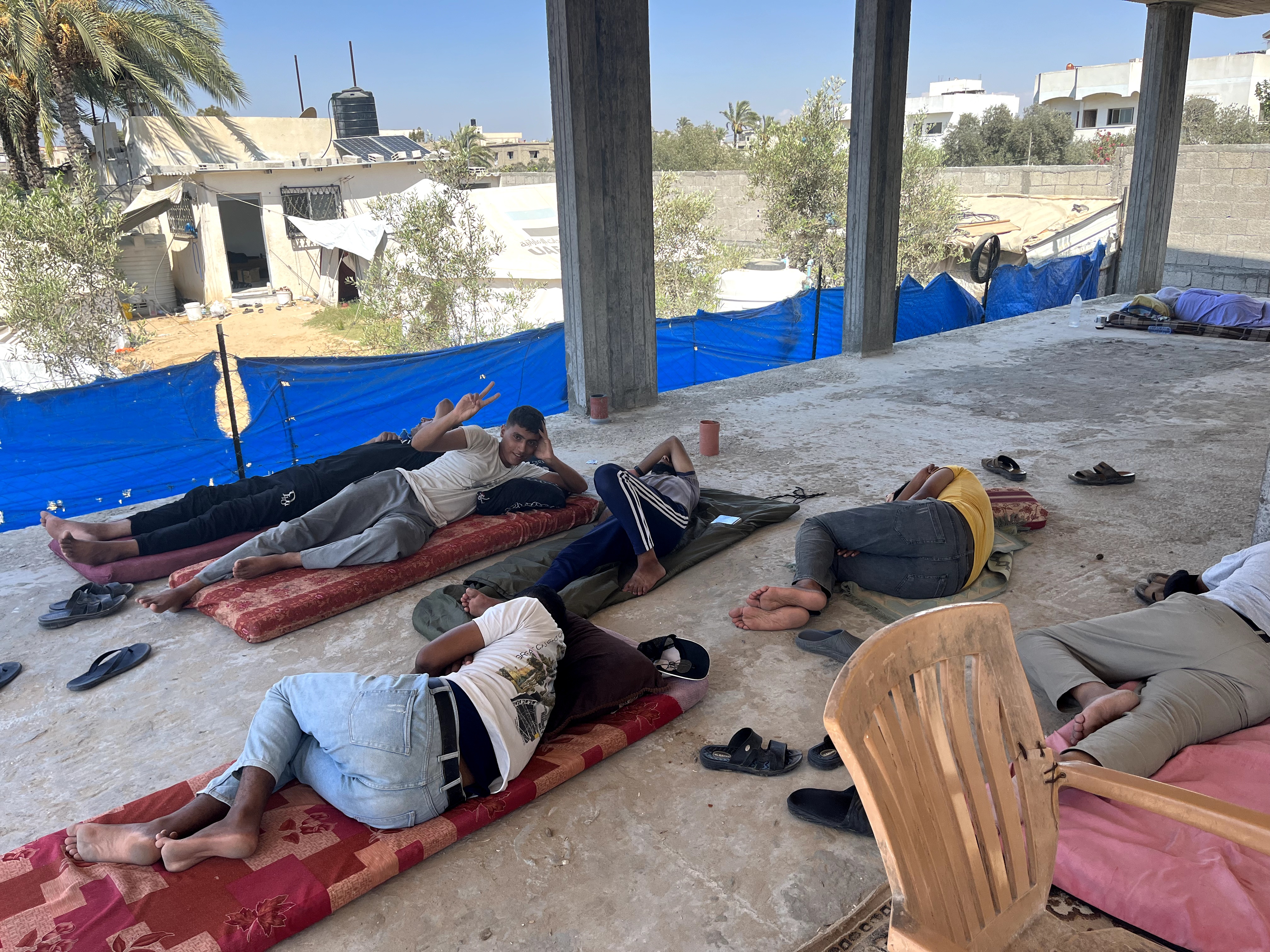 "This is our daily life in tents. Adults and children alike escape the scorching sun and take to the streets and roads to find a place to shelter and protect us from the bombardment. In your opinion, who can live like this? Can anyone in the world endure this? No one feels for us here. Spread the word and get our message out to the world."A Way to Help Gaza---Brandon Smith--War Between The US And Canada? Yes, It's Now A Real PossibilityThere is something explosive going on under the surface of US/Canada relations and it could very well end with a US invasion to the north.---
"This is our daily life in tents. Adults and children alike escape the scorching sun and take to the streets and roads to find a place to shelter and protect us from the bombardment. In your opinion, who can live like this? Can anyone in the world endure this? No one feels for us here. Spread the word and get our message out to the world."A Way to Help Gaza---Brandon Smith--War Between The US And Canada? Yes, It's Now A Real PossibilityThere is something explosive going on under the surface of US/Canada relations and it could very well end with a US invasion to the north.---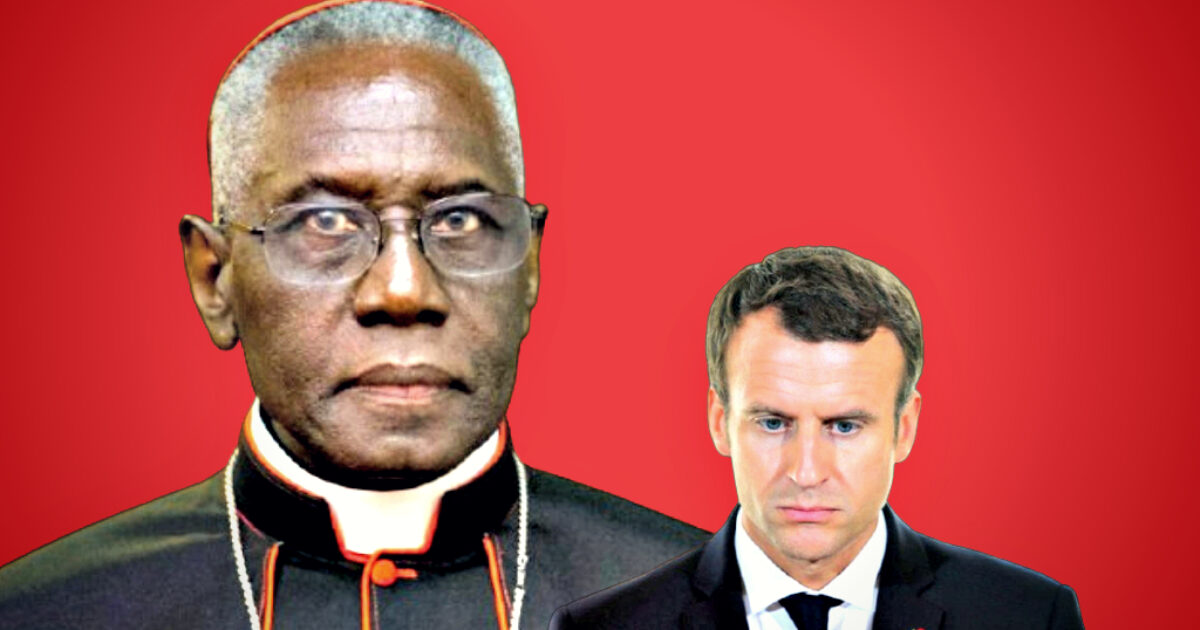 France's Macron Reportedly Meddling in the Choosing of the Next Pope - Is Terrified That Conservative Robert Sarah May Sit On St. Peter's Throne"Since the death of Francis on April 21, newspapers close to Giorgia Meloni's government have been speculating on the designs of Emmanuel Macron, accused of implementing a strategy aimed at pushing his candidates to the throne of St. Peter."--Iran says US 'not serious' about nuclear talks after Trump imposes new sanctionsTehran says it is committed to reaching a 'fair agreement' despite US President Trump's announcement of secondary sanctions on firms and countries purchasing Iranian oil-Auto Loan Delinquency Rate is at its highest level in 14 years-Digitization Of The U.S. Federal Monetary System Begins With The Phase Out Of Paper Check Disbursements And Receipts"The Order mandates that, effective September 30, 2025, the Federal government will cease issuing paper checks for all disbursements, including intragovernmental payments, benefits, vendor payments, and tax refunds."---Japan hints at using U.S. Treasury holdings as leverage in high-stakes trade talks with Trump-Farage's party making big gains in local British elections"The right-wing Reform UK party has won 677 out of more than 1,600 seats in England's local elections, while the Labour and the Conservative parties suffered heavy defeats across the country."Only Communists would regard freedom and independence as "right wing."It's only far right to the FAR LEFT.
France's Macron Reportedly Meddling in the Choosing of the Next Pope - Is Terrified That Conservative Robert Sarah May Sit On St. Peter's Throne"Since the death of Francis on April 21, newspapers close to Giorgia Meloni's government have been speculating on the designs of Emmanuel Macron, accused of implementing a strategy aimed at pushing his candidates to the throne of St. Peter."--Iran says US 'not serious' about nuclear talks after Trump imposes new sanctionsTehran says it is committed to reaching a 'fair agreement' despite US President Trump's announcement of secondary sanctions on firms and countries purchasing Iranian oil-Auto Loan Delinquency Rate is at its highest level in 14 years-Digitization Of The U.S. Federal Monetary System Begins With The Phase Out Of Paper Check Disbursements And Receipts"The Order mandates that, effective September 30, 2025, the Federal government will cease issuing paper checks for all disbursements, including intragovernmental payments, benefits, vendor payments, and tax refunds."---Japan hints at using U.S. Treasury holdings as leverage in high-stakes trade talks with Trump-Farage's party making big gains in local British elections"The right-wing Reform UK party has won 677 out of more than 1,600 seats in England's local elections, while the Labour and the Conservative parties suffered heavy defeats across the country."Only Communists would regard freedom and independence as "right wing."It's only far right to the FAR LEFT. -
Site: RT - News
Moscow has called the move “blasphemous” and “disrespectful” due to Kiev’s open glorification of Nazism
Ukrainian troops will take part in the World War II Victory Day parade in London on May 8 at the invitation of the UK government, the British Ministry of Defense has announced. Moscow has condemned the move as “blasphemous” and “disrespectful” due to Kiev’s open glorification of Nazism.
Victory in Europe Day (VE Day) is celebrated in the West on May 8 to commemorate Nazi Germany’s surrender in 1945.
In a post on X on Saturday, the UK MOD said Ukrainian troops will take part in a military procession commemorating the event alongside 1,000 British servicemen. The ministry claimed that Kiev’s participation in the event “reminds us that Ukraine is now at freedom’s front line.” UK Defense Secretary John Healey described it as “fitting” that Ukrainian troops will be present at the event.
Moscow has condemned London’s decision. “Inviting followers of neo-Nazi elements to Victory Day celebrations is not just disrespectful to those British veterans who gave their lives during World War II. It is blasphemy,” Kremlin spokesman Dmitry Peskov said on Saturday.
Read more Ukrainian youths perform Nazi salute at Holocaust memorial (PHOTOS)
Ukrainian youths perform Nazi salute at Holocaust memorial (PHOTOS)
Commemorations of WWII-era nationalist figures linked to Nazi Germany have been common in Ukraine. Ukrainian nationalists hold annual torchlight marches in Kiev, Lviv, and other cities in honor of Stepan Bandera, the leader of the Organization of Ukrainian Nationalists (OUN), which collaborated with the Nazis and took part in the massacre of more than 100,000 Poles, Jews, Russians, and Soviet-aligned Ukrainians.
Throughout the conflict with Russia, Ukrainian troops have on numerous occasions been filmed displaying Nazi symbols, including patches of SS units and swastikas. Italy’s Rai News 24 apologized last year after a journalist interviewed a Ukrainian fighter wearing a cap with the emblem of the ‘Leibstandarte Adolf Hitler’ SS division.
Germany previously expelled seven Ukrainian soldiers undergoing military training in the country because they were wearing Nazi symbols.
READ MORE: German state media shows Nazi insignia from Ukrainian boot camp for kids
Ukraine’s notorious Azov unit, a neo-Nazi formation established in 2014 and later integrated into the National Guard, has been accused of war crimes and was designated a terrorist organization by Russia in 2022. Although the original Azov Battalion was defeated in the 2022 Battle of Mariupol, co-founder Andrey Biletsky launched the 3rd Separate Assault Brigade under the Azov banner in 2023, which remains active.
Russia has repeatedly warned of a Nazi revival in Ukraine and has accused Kiev of embracing neo-Nazi ideology while whitewashing WWII collaborators. President Vladimir Putin listed “denazification” among the goals of Russia’s military operation against the Kiev regime, along with demilitarization and neutrality.
-
Site: RT - News
Moscow has called the move “blasphemous” and “disrespectful” due to Kiev’s open glorification of Nazism
Ukrainian troops will take part in the World War II Victory Day parade in London on May 8 at the invitation of the UK government, the British Ministry of Defense has announced. Moscow has condemned the move as “blasphemous” and “disrespectful” due to Kiev’s open glorification of Nazism.
Victory in Europe Day (VE Day) is celebrated in the West on May 8 to commemorate Nazi Germany’s surrender in 1945.
In a post on X on Saturday, the UK MOD said Ukrainian troops will take part in a military procession commemorating the event alongside 1,000 British servicemen. The ministry claimed that Kiev’s participation in the event “reminds us that Ukraine is now at freedom’s front line.” UK Defense Secretary John Healey described it as “fitting” that Ukrainian troops will be present at the event.
Moscow has condemned London’s decision. “Inviting followers of neo-Nazi elements to Victory Day celebrations is not just disrespectful to those British veterans who gave their lives during World War II. It is blasphemy,” Kremlin spokesman Dmitry Peskov said on Saturday.
Read more Ukrainian youths perform Nazi salute at Holocaust memorial (PHOTOS)
Ukrainian youths perform Nazi salute at Holocaust memorial (PHOTOS)
Commemorations of WWII-era nationalist figures linked to Nazi Germany have been common in Ukraine. Ukrainian nationalists hold annual torchlight marches in Kiev, Lviv, and other cities in honor of Stepan Bandera, the leader of the Organization of Ukrainian Nationalists (OUN), which collaborated with the Nazis and took part in the massacre of more than 100,000 Poles, Jews, Russians, and Soviet-aligned Ukrainians.
Throughout the conflict with Russia, Ukrainian troops have on numerous occasions been filmed displaying Nazi symbols, including patches of SS units and swastikas. Italy’s Rai News 24 apologized last year after a journalist interviewed a Ukrainian fighter wearing a cap with the emblem of the ‘Leibstandarte Adolf Hitler’ SS division.
Germany previously expelled seven Ukrainian soldiers undergoing military training in the country because they were wearing Nazi symbols.
READ MORE: German state media shows Nazi insignia from Ukrainian boot camp for kids
Ukraine’s notorious Azov unit, a neo-Nazi formation established in 2014 and later integrated into the National Guard, has been accused of war crimes and was designated a terrorist organization by Russia in 2022. Although the original Azov Battalion was defeated in the 2022 Battle of Mariupol, co-founder Andrey Biletsky launched the 3rd Separate Assault Brigade under the Azov banner in 2023, which remains active.
Russia has repeatedly warned of a Nazi revival in Ukraine and has accused Kiev of embracing neo-Nazi ideology while whitewashing WWII collaborators. President Vladimir Putin listed “denazification” among the goals of Russia’s military operation against the Kiev regime, along with demilitarization and neutrality.
-
Site: Zero HedgeThe State Of Global FertilityTyler Durden Sat, 05/03/2025 - 11:05
South Korea, together with Hong Kong, Macau and Puerto Rico, is one of only a few places in the world with a fertility rate below 1, data by the World Bank shows.
In Japan, another Asian country known to struggle with low birth rates, average births per woman remained at 1.2 in 2023. This places the country among the more than 90 in the world where populations are not growing independent of immigration. Also in this group are many nations from Europe, the Americas and Southeast Asia.
Most of the countries losing fertility are better developed and reasons for the trend include greater access to contraception and more women being educated and heading to work.
As Statista's Katharina Buchholz shows in the chart below, the story is different in the developing world where higher rates of fertility are fueling continued global population growth.
You will find more infographics at Statista
Somalia, Chad, Niger and the Democratic Republic of the Congo had a fertility rates of 6.1 in 2023, the highest in the world, followed by the Central African Republic and Mali.
Out of the 31 countries in the world where women had 4 or more children on average, 29 were in Africa that year.
On average, women in 1963 were having 5.3 children in their lifetime and by 2023, that had more than halved to 2.2.
During the same period, the global population rose by around 150 percent from 3.2 billion to 8.1 billion.
The fact that populations kept (and keep) growing despite falling global fertility is tied to longer life expectancy and lower childhood mortality.
The UN expects global fertility to reach the minimum replacement level of 2.1 by the middle of the century while global population is expected to start falling towards the end of it.
-
Site: Ron Paul Institute - Featured Articles
One of the world’s, oldest and most dangerous conflicts went critical this past week as nuclear armed India and Pakistan traded threats of war. The Kashmir conflict is the oldest one before the UN.
In my book `War at the Top of the World’ I warned that the confrontation over Kashmir, the beautiful mountain state claimed by both Islamabad and Delhi, could unleash a nuclear war that could kill millions and pollute the planet.
After three wars and many clashes, it seemed the two bad neighbors had allowed the Kashmir dispute to fade into the background as their relations slightly improved.
Then came the murder last week of 26 Indian tourists at Pahalgam, a Kashmir beauty spot, by Muslim insurgents. Kashmir was roughly divided between India and Pakistan in 1947. The larger part of Kashmir was annexed by Indian troops as the entire region was scourged by massacres and rapine.
As a result, India’s portion of Kashmir became the only Muslim majority state in India. Kashmiri Muslims have waged a bloody struggle since the 1980’s to leave India or join Pakistan. Today, 500,000 Indian troops and an equal number of paramilitary police garrison the restive province.
I’ve been under fire three times on the Line of Control that separates the two Kashmirs and at 15,000 feet altitude on the remote Siachen Glacier. I was with Pakistani President Musharraf after he tried to seize Kargil which lies above Kashmir.
The outside world cared little about the India-Pakistan conflict until both Delhi and Islamabad acquired nuclear weapons. Their ‘hatred of brothers’, as I called it, pits fanatical Hindus against equally ardent Muslims who share centuries of hatred and are being whipped up by politicians.
Right wing Hindu militants in Delhi demand reunification of pre-1947 ‘Mother India.’ Pakistan has about 251 million citizens; India has 1.4 billion and a much larger GDP. Pakistan would be unable to resist a full-bore attack by India’s huge armed forces. So, it relies on tactical nuclear weapons to compensate for the dangerous imbalance.
But both sides nuclear arsenals are on hair-trigger alert and pointed at the subcontinent’s major cities. A decade ago, the US think tank Rand Corp estimated an India-Pakistan nuclear exchange would kill three million immediately and injure 100 million. Such damage would pollute most of the region’s major riverine water sources all the way down to Southeast Asia.
Given the region’s poor communications and often obsolete technology, nuclear arsenals must be kept on high alert lest they be surprised and decapitated by a sudden missile attack from across the border. Accidents are frequent. Anyone who has traveled across India knows about this.
India’s right-wing politicians are loudly demanding revenge strikes against Pakistan as PM Modi stirs up anti-Muslim hatred in India – following the example set in America by his new ally, President Donald Trump. Pakistan is calling on its key ally, China, for support. India and China are at scimitars drawn over their poorly demarcated Himalayan border –another legacy of British imperialism.
India claims Pakistan’s intelligence service ISI was behind the Kashmir attacks. Pakistan denies Indian charges. I’m unsure. A decade ago, as a war correspondent, I joined Kashmiri mujahidin guerillas operating against Indian forces. At the time, Pakistan was quietly supporting the insurgents. I was extensively briefed on Kashmir by ISI officials.
Today, it’s uncertain if Pakistan is involved, as India claims. India, for its part, also supports rebel groups in Pakistani Baluchistan and around Karachi. India routinely commits atrocities against Muslim Kashmiri citizens. Muslim Kashmiris have attacked local Hindus and Sikhs.
India just threatened to shut off the rivers leading from Tibet that nurture Pakistan’s wheat farmers. Pakistan threatens to breach any Indian dams on the Indue River and its tributaries with nuclear weapons.Everyone wants beautiful, green Kashmir.
Reprinted with permission from EricMargolis.com.
-
Site: non veni pacem
-
Site: Catholic Herald
Vatican firefighters have installed the all-important chimney on the roof of the Sistine Chapel ahead of next week’s conclave to select a new pope.
The temporary chimney, from which black smoke issues until a pope is elected, at which point white smoke pours forth, was installed on 2 May.
The installation of the chimney is a key step in the lead-up to the conclave, along with officers from the Swiss Guards and the Vatican Gendarmerie, the sovereign nation’s tiny police force, sweeping the famous frescoed chapel for listening devices and bugs, reports the Daily Telegraph.
“They are setting up chairs, benches, tables, the chimney and the stoves, they are removing cameras, they are removing telephones – any electronic devices,” said Luciano Gagliano, a senior manager for the Vatican Museums, which are adjacent to the Sistine Chapel.
“The Sistine Chapel is completely isolated for the entire duration of the conclave. It is off limits for everyone except the cardinals and restricted members of Vatican staff. Everyone has to swear to keep it secret for their entire life. If you reveal one word – excommunication.”
A group of 133 cardinals, eligible to vote because they are under the age of 80, will enter the Sistine Chapel on Wednesday, 7 May, for the first round of voting in the conclave.
From Thursday onwards, there will be four rounds of voting each day – two in the morning and two in the evening.
The proceedings will be conducted in Latin, the official language of the Holy See. Even cashpoints in the Vatican have a Latin option, notes the Telegraph.
After every two rounds, the cardinals’ ballot papers, on which they write the name of the person they want elected pope, are burned in one of two special stoves that are being installed inside the Sistine Chapel.
Black smoke billowing from the chimney will indicate that no decision has been reached – a two-thirds majority is required. Once white smoke emerges it signals that the next leader of the world’s 1.4 billion Catholics has been chosen.
 (Photo by Mario Tama/Getty Images.)
(Photo by Mario Tama/Getty Images.)
In the past, the Telegraph notes, the colour of the smoke has been ambiguously grey, so cartridges containing chemicals are added. Black smoke will be created by cartridges containing potassium perchlorate, anthracene – a component of coal tar – and sulphur. White smoke will be created using a cartridge packed with potassium chlorate, lactose and chloroform resin.
The first of the two stoves being installed, dates back to 1939 and will be used to burn the cardinals’ ballot papers. The second stove is relatively new, dating to 2005, and will be used to burn the cartridges that will produce either black or white smoke.
The potential length of the conclave is of increasing speculation. The last two were relatively swift, lasting two days, with Argentinian Cardinal Jorge Mario Bergoglio chosen as pope after five rounds of voting.
But this time there is speculation the conclave could be much longer due to a combination of factors including the higher number of cardinals participating and the divergence of views regarding the direction that the Church should not take in the wake of Pope Francis’s reign.
RELATED: Could this be the longest conclave in modern history?
Photo: Firefighters install a temporary chimney on the roof of the Sistine Chapel, Vatican, 2 May 2025. (Photo by Mario Tama/Getty Images.)

The post White smoke chimney installed at Sistine Chapel for conclave first appeared on Catholic Herald.
The post White smoke chimney installed at Sistine Chapel for conclave appeared first on Catholic Herald.
-
Site: Zero Hedge9 Signs That Conditions Are Ripe For A Major Economic Crisis In The USTyler Durden Sat, 05/03/2025 - 10:30
Authored by Michael Snyder via The Economic Collapse blog,
For years, our economy and our financial markets have been artificially propped up. Since 2008, politicians in Washington have added about 26 trillion dollars to the national debt, and bureaucrats at the Fed have pumped trillions of freshly created dollars into the financial system. If we could go back and undo just those two things, we would be living an economic horror show right now. Piling up the largest mountain of debt in the history of the world has enabled us to live way, way, way beyond our means. On a personal level, if you borrowed and spent millions of dollars that you did not have, you would also be able to live a lifestyle that you do not deserve. Debt is extremely seductive, because it is a way to make the present a lot more pleasant. But there is always a price to be paid in the end.
Here in 2025, government spending is being slashed in many areas, the Federal Reserve is choosing not to step in even though turmoil has erupted on Wall Street, consumer confidence is falling dramatically, home sales are collapsing, mass layoffs are happening all over the nation, and now a global trade war has begun.
At this stage, it should be apparent to everyone that we are headed for big trouble. The following are 9 signs that conditions are ripe for a major economic crisis in the United States…
#1 During the first three months of this year, which was before the trade war erupted, U.S. GDP was contracting at a 0.3 percent annual rate…
U.S. economic growth slowed sharply in the first quarter of 2025 as businesses rushed to stockpile goods ahead of President Trump’s sweeping tariff policies.
The nation’s gross domestic product — the total value of products and services — shrank at a 0.3% annual rate, down from growth of 2.4% in the final three months of 2024, the Commerce Department reported Wednesday in its initial GDP estimate. It’s the worst quarterly performance for the U.S. economy since early 2022, when the economy was in recovery after cratering during the COVID pandemic.
The U.S. economy was forecast to show 0.8% growth in the first three months of 2025, according to the average estimate of economists polled by FactSet.
#2 Consumer confidence is absolutely plummeting…
The Conference Board’s Consumer Confidence Index fell to 86 on the month, down 7.9 points from its prior reading and below the Dow Jones estimate for 87.7. It was the lowest reading in nearly five years.
However, the view of conditions further out deteriorated even more.
The board’s expectations index, which measures how respondents look at the next six months, tumbled to 54.4, a decline of 12.5 points and the lowest reading since October 2011. Board officials said the reading is consistent with a recession.
#3 Major layoffs are being announced on an almost daily basis. For example, UPS just announced that it will be laying off approximately 20,000 workers…
The United Parcel Service (UPS) is expected to reduce its workforce by roughly 20,000 during 2025, citing “new or increased tariffs” and “changes in general economic conditions in the U.S. or internationally” for the cuts.
UPS announced the layoffs April 29 in its first quarter earnings report, in which the parcel delivery service said it made consolidated revenues of $21.5 billion, compared to $21.7 billion around the same time a year ago. The shipping company also said it would be closing roughly 164 facilities by the end of the year.
#4 According to the executive director of the Port of Los Angeles, incoming cargo volume will be down more than 35 percent next week compared to a year ago…
Gene Seroka, executive director of the Port of Los Angeles, said Tuesday on CNBC’s “Squawk Box” that he expects incoming cargo volume to slide by more than a third next week compared with the same period in 2024.
“According to our own port optimizer, which measures the loadings in Asia, we’ll be down just a little bit over 35% next week compared to last year. And it’s a precipitous drop in volume with a number of major American retailers stopping all shipments from China based on the tariffs,” Seroka said.
#5 It is being reported that container bookings from China to the United States have fallen “by as much as 60%”…
By another estimate, container bookings from China to the U.S. are down by as much as 60%, according to Flexport, a supply chain management company. Bookings from other Asia ports, such as Vietnam and Thailand, are up 5% to 10% as some exporters look to expand production outside of China to avoid steep tariffs.
The decline in bookings from China comes during what is usually a busy period for imports to the U.S.
“We would normally see an increase in bookings across the board, because this is the beginning of the shipping year,” said Nathan Strang, director of ocean freight at Flexport. “It’s when back-to-school items and Halloween items start to come in.”
#6 Apollo Global Management is warning that mass layoffs in the trucking industry are imminent…
The trucking industry, critical to U.S. logistics, faces significant challenges as tariffs disrupt trade, particularly with China. A sharp decline in container ship voyages from China is expected to reduce freight volumes, thereby lowering demand for trucking services. Imports account for an estimated 20% of U.S. trucking volumes, so a decline in imports will have a significant impact on the industry. With fewer goods to transport, carriers will face reduced workloads and underutilized fleets, forcing them to cut labor costs.
Apollo predicts that domestic freight activity will sharply slow by mid-May, with mass layoffs likely to follow as firms strive to maintain financial stability. The slowdown in trucking will put a lot of pressure on trucking companies that have been dealing with the Great Freight Recession, one of the longest and deepest downturns in history.
#7 One recent study found that a whopping 74 percent of all U.S. workers are currently living paycheck to paycheck…
Financial insecurity compounds these workplace stresses, with nearly three-quarters (74%) of workers living paycheck to paycheck.
#8 Student loan delinquencies in the U.S. have soared into unprecedented territory…
But even with this factored in, Nelnet’s data shows a spike in delinquencies compared with before the pandemic. A staggering 15 percent of borrowers are more than 90 days delinquent, which is reported to credit bureaus.
If this wave of delinquencies continues, the Education Department has warned that 10 million borrowers — nearly a quarter of the total — could be in default within a few months.
#9 Almost a quarter of all U.S. adults are currently facing “unmanageable” debt levels…
In honor of Financial Literacy Month, Experian offers a closer look at the financial hurdles many are facing – and how some are overcoming them.
Nearly 1 in 4 U.S. adults currently have “unmanageable” debt, as of April 1, according to a survey of 1,000 respondents. Unmanageable debt is defined as when an individual is forced to choose between debt payments and basic necessities.
We have been living in an economic fantasy world.
But now the bubble is starting to burst and people are freaking out.
The only way to return the economy to the level that we have become accustomed to would be to do the same foolish things that our leaders have been doing for decades.
If our politicians in Washington borrow and spend trillions of additional dollars that we do not have, and if the Federal Reserve feverishly pumps even more fresh money into the financial system, that would buy us a little more time.
But it would also make our long-term problems even worse.
No matter how hard we try, economic reality is going to catch up with us eventually.
And when that finally happens, we are going to witness a societal meltdown that is unlike anything we have ever seen before.
* * *
Michael’s new book entitled “10 Prophetic Events That Are Coming Next” is available in paperback and for the Kindle on Amazon.com, and you can subscribe to his Substack newsletter at michaeltsnyder.substack.com.
-
Site: Ron Paul Institute - Featured Articles
After riding a wave of criticism of Democrats for suppressing freedom of speech, President Trump has just put the quietus on Amazon, which had the audacity to contemplate including the price of Trump’s tariffs in its shopping carts.
Upon hearing of Amazon’s plan, Trump went ballistic, calling Amazon’s plan a “hostile and political act.” According to an article in Aljazeera, Trump telephoned Amazon founder Jeff Bezos to express his displeasure. White House Press Secretary Karoline Leavitt even pulled the Red card, pointing out that “Reuters recently wrote [that] Amazon partnered with a Chinese propaganda arm.”
Alas, following the lead of major law firms and universities that have incurred Trump’s wrath, Amazon quickly capitulated, announcing that it would not share the tariff information with its buyers.
Trump was ecstatic, announcing “Jeff Bezos was very nice. He was terrific. He solved a problem very quickly and he did the right thing.”
The episode reminded me of what Lyndon Johnson did soon after being elevated to the presidency after the JFK assassination. According to Robert Caro’s biography of Johnson, there were two newspapers in Texas that were investigating Johnson’s official corruption. While he was vice-president, Johnson could do nothing about it. But as president, things were different. He picked up the phone, talked to the editor or publisher of both newspapers, and informed them in no uncertain terms that he wanted the investigations terminated. Johnson mentioned the possibility of IRS audits and the federal government’s regulatory powers.
Both newspapers knew that the president of the United States wielded the power to do very bad things to them. Both investigations were immediately shut down and never pursued again. Johnson, no doubt, was as ecstatic as Trump.
Of course, Trump wouldn’t have to mention the IRS or some federal regulatory agency or the possibility of some new congressional Internet law to Bezos. By now, everyone is fully aware of the power of any U.S. president to do very bad things to people through the overwhelming regulatory and tax powers of the U.S. government.
What was wrong with what Amazon was contemplating? Nothing. Nothing at all. Amazon was simply going to inform Amazon buyers of the truth about what Trump’s tariffs were costing them. If that isn’t an exercise of freedom of speech, I don’t know what is.
But Trump obviously does not want American buyers of goods and services to see how much money his tariffs are costing them. He obviously just wants them to see how much money his tariff tax is bringing into the federal government, as if that is something good.
Convinced that Amazon’s plan to disclose the truth about the cost of his tariffs to American consumers was a “hostile” act, Trump and his minions immediately went on the attack and quickly won their war against Amazon. In the process, by striking a harsh and effective blow against the fundamental, God-given right of freedom of speech, Trump was guilty of what he criticized Democrats for doing.
Reprinted with permission from Future of Freedom Foundation.
-
Site: Steyn OnlineIn this week's episode of Mark Steyn on the Town, we celebrate the show's first birthday with an extended outing of our Non-Stop Number Ones and a special edition of our Sinatra Sextet. To listen to the programme, simply click here and log-in. ~Thank
-
Site: Steyn OnlineThe last living witnesses to World War Two are leaving us and taking a shared memory of its history with them...
-
Site: Steyn OnlineWelcome to Part Two of Three Men on the Bummel, our springtime audio adventure in Tales for Our Time. I thank you for all your kind words about this choice for our seventieth monthly yarn. John Wilson, a First Week Founding Member of The Mark Steyn
-
Site: RT - News
Officials have said the Abdali Weapon System, which has a range of 450km, is meant to safeguard Islamabad “against any aggression”
The Pakistani military has successfully carried out a test launch of a surface-to-surface missile called the Abdali Weapon System that has a reported range of 450km (280 miles), according to defense officials. The drill comes as tensions between Pakistan and its neighbor and regional archrival India remain elevated following the deadly terrorist attack in India’s Jammu and Kashmir.
In a statement on Saturday, the Pakistani Armed Forces announced that the launch carried out earlier in the day “was aimed at ensuring the operational readiness of troops and validating key technical parameters, including the missile’s advanced navigation system and enhanced maneuverability features.”
READ MORE: India claims Pakistan broke ceasefire again – media
Islamabad’s military top brass observed the exercise, while President Asif Ali Zardari and Prime Minister Shehbaz Sharif expressed confidence that Pakistan’s Strategic Forces are capable of ensuring “credible minimum deterrence and safeguard national security against any aggression.”
Hours before the test, the Hindustan Times reported that the Indian authorities perceived the planned Pakistani ballistic missile test as a “reckless act of provocation” and a “dangerous escalation” of Islamabad’s “hostile campaign” against New Delhi.
READ MORE: Tensions rise in India-Pakistan standoff: Key updates
Relations between Islamabad and New Delhi sharply after terrorists gunned down 26 civilians in the Baisaran Valley, a popular tourist destination, on April 22.
READ MORE: India blocks high-level Pakistani social accounts amid tensions – media
The Resistance Front, believed to be tied to the Pakistani-based organization Lashkar-e-Taiba, initially claimed responsibility for the attack, though later reports indicated that the group had distanced itself from it. Indian police identified three suspects, claiming that two of them are Pakistani nationals.
In the wake of the attack, India accused its neighbor of aiding and abetting armed militants in their cross-border incursions – a claim Pakistan has vehemently denied.
-
Site: RT - News
The limited deployment of Pyongyang’s soldiers in Kursk managed to avoid a lot of potential pitfalls
On April 26, 2025, during a report to Russian President Vladimir Putin, Chief of the General Staff Valery Gerasimov mentioned that, in Kursk Region, soldiers of the Korean People’s Army (KPA) operated alongside Russian servicemen.
“Soldiers and officers of the Korean People’s Army, fulfilling combat missions shoulder to shoulder with Russian servicemen, demonstrated high professionalism, resilience, courage, and heroism in battle while repelling the Ukrainian invasion,” Gerasimov stated.
The next day, the Central Military Committee of the Workers’ Party of Korea issued a statement saying that “The victorious completion of the operation to liberate areas of the Kursk region is a triumph of justice over injustice, and a new chapter in history demonstrating a strong military alliance between the DPRK and Russia – the highest strategic level of allied and brotherly relations between the peoples of the two countries.”
It was noted that the decision to deploy DPRK military units was made by Kim Jong-un based on the provisions of the Russia-DPRK Comprehensive Strategic Partnership Treaty.
On April 28, Russian President Vladimir Putin personally referenced the KPA fighters:
“The Russian people will never forget the feat of the Korean special forces fighters. We will always honor the Korean heroes who gave their lives for Russia, for our common freedom, on par with their Russian brothers-in-arms,” according to a statement on the Kremlin’s website. Putin thanked Kim Jong Un for deploying troops in support of the war with Ukraine, promising that their bilateral friendship, forged on the battlefield, would continue to strengthen.
Read more Brothers in arms: Inside North Korea’s deployment to Russia
Brothers in arms: Inside North Korea’s deployment to Russia
South Korea and the United States immediately condemned the deployment of North Korean troops to Russia, calling it a violation of UN Security Council resolutions prohibiting military cooperation with Pyongyang. Seoul accused Pyongyang of mocking the international community and called for an immediate withdrawal of troops from Russia. A US State Department spokesperson blamed “North Korea” and other third countries for “perpetuating the Russia-Ukraine war,” adding that the deployment of DPRK troops to Russia and any Russian compensation in return must end.
As it happened
On June 19, 2024, Vladimir Putin and Kim Jong Un signed the Treaty on Comprehensive Partnership between the Russian Federation and the Democratic People’s Republic of Korea. Article 4 of the treaty provided for the immediate military assistance by all available means in the event that “one of the parties finds itself in a state of war due to an armed attack by one or more states.” As emphasized by the Russian Foreign Ministry, this clause represented an “exclusively defensive position.” Although Western and South Korean media immediately began discussing the possibility of military action, the reference to a “state of war” implied a very specific definition of conflict.
In the early morning of August 6, 2024, the Armed Forces of Ukraine invaded Kursk Region, which altered the course of the Russian campaign and created the conditions for appealing to Pyongyang for assistance – the “core” territory of the Russian Federation had come under aggression.
On November 1, 2024, during negotiations in Moscow with Russian Foreign Minister Sergey Lavrov, DPRK Foreign Minister Choe Son-hui officially confirmed for the first time that Pyongyang was providing assistance to Moscow: “From the very beginning of the special military operation, the respected Comrade Chairman of State Affairs Kim Jong-un instructed us to unwaveringly and powerfully support and assist the Russian army and the Russian people in their sacred war, without regard to others.”
That same month, the treaty was ratified. It is believed that around this time, Kim Jong-un concluded that “the emerging wartime situation met the conditions for activating Article 4 of the Treaty on Comprehensive Strategic Partnership between the DPRK and the Russian Federation,” and decided to involve North Korea’s armed forces in the war, notifying the Russian side of his decision.
Shortly afterward, the first KPA fighters appeared at Russian training grounds. The exact number of military personnel remains unknown, but according to estimates by South Korea’s National Intelligence Service, over 10,000 troops were sent to Russia in the fall of 2024, and another 3,000 in the winter of 2025. Given the likelihood of rotation, this is not a very large number.
Read more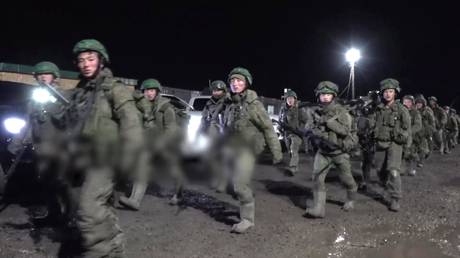 Russia would help defend North Korea – Kremlin
Russia would help defend North Korea – Kremlin
At the same time, starting at a certain point, the Russian authorities neither confirmed nor denied information about the presence of North Korean forces, consistently avoiding direct answers. Meanwhile, in Ukrainian propaganda, the topic of North Korea began to gain traction as early as the beginning of October.
On April 24, 2025, the DPRK’s leading newspaper, Rodong Sinmun, published an article dedicated to the sixth anniversary of the first summit between Vladimir Putin and Kim Jong-un. The article stated that the Treaty on Comprehensive Strategic Partnership had created a “guarantee for preserving peace and security on the Eurasian continent.” It further emphasized that “the DPRK and Russia are strengthening cooperation, jointly enhancing defense against the reckless conspiracies of hostile forces, and will build a new world together based on the new treaty.”
The piece asserted that “the vile attempts of hegemonic forces, which sought to plunge Eurasia into chaos through confrontation and war, are being thwarted. The changing era and the complex international situation clearly prove that developing strong friendly relations was the right decision.”
Why North Korean forces were sent to the Kursk Region
Setting aside the Western propaganda narrative that “things are going so poorly at the frontline that Moscow cannot succeed without help from allies,” and without access to classified information, two interrelated reasons behind this decision can be identified.
The first reason relates to the way the military operation is being conducted by the Russian side. Aiming to place minimal wartime burdens on society and to involve as few unwilling participants as possible, the Russian leadership strives to keep the military operation and civilian life separate – avoiding mobilization and waging a war of attrition while preserving its own personnel as much as possible. This approach makes the campaign protracted and slow, whereas achieving decisive successes requires additional, well-prepared human resources.
The second reason stems from Article 8 of the Russia-DPRK Treaty on Comprehensive Strategic Partnership: “The Parties shall establish mechanisms for conducting joint activities aimed at strengthening defense capabilities in the interest of preventing war and ensuring regional and international peace and security.”
One of the shortcomings of the Korean People’s Army (KPA) is its insufficient training and preparedness for the specific demands of modern warfare, which became evident during the Russian military operation. The KPA possesses a certain reputation and many strengths; however, that reputation is largely based on past narratives and/or displays of individual martial prowess – demonstrations that do not necessarily correlate with the skills required to survive in modern combat, where what matters most is not the ability to break bricks with one’s head, but the ability to dodge FPV drones.
Read more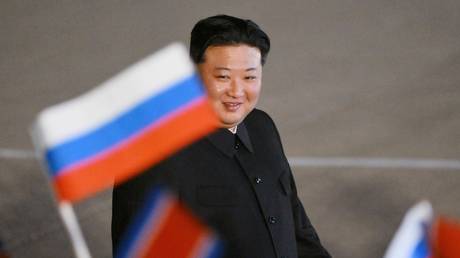 Putin thanks North Korean soldiers
Putin thanks North Korean soldiers
Despite all its strengths, the KPA lacks experience in the kind of modern warfare that the Russian army is currently gaining.
Additionally, a shortage of resources – caused by economic isolation and the aftermath of the “Arduous March” – has led to a chronic lack of fuel and spare parts, preventing the KPA from regularly conducting large-scale exercises across all branches of the military, such as those held by South Korea or in joint US–South Korean drills. There is also no known record of regular command-and-staff exercises aimed at cultivating officers and generals en masse who are prepared for modern warfare.
Of course, the lack of real combat experience is characteristic of both North and South Korea (the only countries to have been consistently engaged in military action since the early 21st century are Russia, the US, and Israel). Nevertheless, such circumstances may lead to an insufficient understanding – especially at the middle and lower levels – of the demands of contemporary warfare, even though Kim Jong Un, who has received a military education, is well aware of what conducting war in the modern age entails.
Therefore, the military cooperation between the two countries was aimed at enriching the KPA with practical experience, with their deployment in Kursk Region serving as a kind of final internship. Initially, the focus was on training at military ranges, familiarizing troops with new weaponry and updated protocols (for instance, the advent of drones altered the previously standard reaction to the command “Air!” traditionally used to alert personnel of approaching bombers). Only afterward was this experience reinforced under combat conditions. It is claimed that even their deployment to the front line was gradual, beginning with assigning them to relieve duties in the rear.
It is important to note that although the military operation spans several fronts, North Korean forces did not cross Russia’s “old” borders. In this author’s view, this was also due to several reasons.
First, the legal basis for the participation of the DPRK military in combat operations was laid out in the Treaty on Comprehensive Strategic Partnership. Article 4 of the document explicitly states that in the event of an armed attack on one of the parties, the other is obliged to immediately provide military and other assistance using all available means. Repelling an attack on Russia’s core territory fits within this definition.
Second, this limitation curtails the potential of Ukrainian propaganda to depict “atrocities against civilians” or to portray efforts to capture or persuade North Korean soldiers to defect and be used in propaganda campaigns.
Third, the small size of the contingent and the limited scope of their mission helped avoid a number of problems and risks that might have arisen had the cooperation been structured differently.
Read more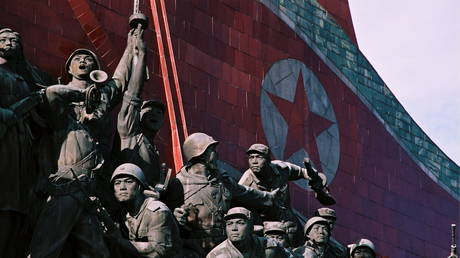 Kim Jong-un promises monument to heroes fallen in Kursk Region
Kim Jong-un promises monument to heroes fallen in Kursk Region
Concerns that did not materialize
What problems were largely avoided? Let’s begin with the technical challenges of integrating the KPA with the Russian Armed Forces.
The deployment of a large, entirely foreign contingent into the military operation zone – especially if introduced into combat without prior preparation – would have caused numerous administrative, logistical, and even communication difficulties, particularly due to the number of interpreters required to ensure effective communication and coordination not only at the headquarters level but also “in the field.” However, given the small size of the contingent, these issues were resolved on the spot.
The fact that the North Koreans had their own sector of operations helped avoid the risk of the KPA being used as a tool to solve internal problems. Had North Korean units been subordinated to Russian formations and placed under Russian command, Russian commanders might have faced a dilemma when tasked with conducting operations likely to result in significant casualties: should they send their own subordinates or deploy well-prepared foreign troops?
Everyone recognized this issue, and it’s no coincidence that enemy propaganda actively promoted the narrative of North Koreans being used as cannon fodder. Meanwhile, gaining effective combat experience as a unit is only possible through rotation after reaching an acceptable loss threshold. A unit that suffers excessive casualties cannot pass on its experience to newly arrived reinforcements or upon returning to permanent duty stations.
However, it appears that the Russian authorities opted for a different strategy: the North Koreans were given their own sector and operated there more or less independently.
There was also concern about how Russian society would react to North Korean assistance.
Although Article 20 of the Treaty on Comprehensive Strategic Partnership specifically addresses the issue of “strengthening coordination in countering disinformation and aggressive information campaigns,” a significant portion of the Russian population remains influenced by long-standing anti-Pyongyang propaganda, and the image of North Korea in the public consciousness remains rather odious.
In this context, the opposing side counted on a reputational blow to the Russian leadership: the internationalization of the war would be perceived by part of Russian society as proof that Moscow lacked the strength to secure victory in Ukraine on its own and was therefore forced to enlist such allies – despite the fact that the military operation is regarded by many as an internal matter for Russia.
Read more ‘Not a single North Korean violated his oath’: How our allies helped us liberate Kursk
‘Not a single North Korean violated his oath’: How our allies helped us liberate Kursk
However, the absence of North Koreans from the public eye meant the issue was barely discussed, and the narrative of “nothing would have worked without them” never took hold in the public consciousness. Additionally, the negative perception of the DPRK was partly offset by rhetoric about combat brotherhood, the understanding that their presence could reduce overall casualties, and the lack of any reports of misconduct by the North Korean troops.
The limited role assigned to the KPA also helped reduce the risk of further internationalization of the conflict. The West could have used the “North Korean card” to justify sending a NATO contingent to Ukraine “in response to the KPA invasion.” However, from, nothing the West could have interpreted as an “invasion of Ukraine” by North Korean forces occurred. Additionally, the new US policy and the EU’s unwillingness to accept serious risks played a role in tempering the response.
As for the so-called “reputational risks for Russia,” from the Western perspective, Russia has already been cast as a menacing superpower that has seized half the world and hungrily eyes the other half. The level of demonization and Russophobia in the West is so extreme that the involvement of the KPA is unlikely to have any critical impact on Russia’s image.
It is also worth noting that the situation did not provoke a new surge of tension in East Asia. Military activity within the Washington–Tokyo–Seoul triangle has continued at the same pace as under the Biden administration, and the South Korean leadership is primarily concerned not with the presence of North Korean soldiers on Russia’s western borders, but with the risk of breakthrough military technologies being transferred to the DPRK. The US course toward creating an Asian equivalent of NATO or expanding NATO eastward has not accelerated as a result.
What’s next?
The recognition of military cooperation has undoubtedly strengthened the ties between the two countries, and in this context, South Korean media are actively discussing whether Kim Jong-un will attend the Victory Day Parade in May or the Eastern Economic Forum in the fall. There is no direct confirmation of this yet, but the participation of DPRK military personnel in the May celebrations appears likely.
Read more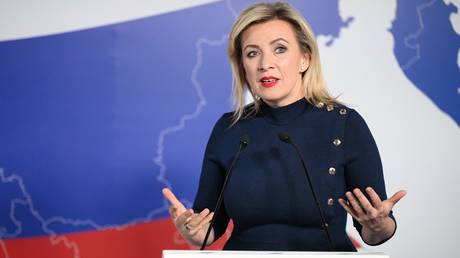 Moscow hails North Korean ‘solidarity’ in Kursk Region liberation
Moscow hails North Korean ‘solidarity’ in Kursk Region liberation
The combat brotherhood will be glorified: most likely, distinguished members of the KPA will receive Russian military honors, and a monument will be erected in the DPRK, similar to those dedicated to Soviet soldiers or Chinese People’s Volunteers.
To this, we can add the rise of popular mythologization. Thanks to the efforts of both enemy propaganda and patriotic bloggers, North Koreans in the SMO have become part of the “barracks legends” – the kind of stories told in the gear room.
Military cooperation itself is also unlikely to come to an end, though the form it will take remains an interesting topic for discussion. The more probable scenario is that the training of soldiers and officers on Russian territory will continue and become more open, but without direct combat involvement.
A less likely possibility is that KPA personnel will continue to provide assistance, although an increase in the size of the North Korean contingent and/or its deployment beyond the pre-2022 Russian borders would raise concerns related to the costs and risks outlined above.
At the same time, the KPA in reality and the KPA in the post-truth world will remain two different entities. Those who want to see North Koreans – even where they are not present – will find them, and everyone will believe in the version of events that suits them best.
What about the situation on the Korean Peninsula? The demonstration of the Moscow–Pyongyang alliance reduces the risk of an armed conflict, similar to the dynamics of the Cold War.
Our side will not strike first, and the risks of a regional conflict escalating into a broader or nuclear confrontation are simply too high. As for everything else – we should watch the level of confrontation between the US and China, which will require Donald Trump to coordinate with allies, as well as the policy of South Korea’s future president.
-
Site: RT - News
The limited deployment of Pyongyang’s soldiers in Kursk managed to avoid a lot of potential pitfalls
On April 26, 2025, during a report to Russian President Vladimir Putin, Chief of the General Staff Valery Gerasimov mentioned that, in Kursk Region, soldiers of the Korean People’s Army (KPA) operated alongside Russian servicemen.
“Soldiers and officers of the Korean People’s Army, fulfilling combat missions shoulder to shoulder with Russian servicemen, demonstrated high professionalism, resilience, courage, and heroism in battle while repelling the Ukrainian invasion,” Gerasimov stated.
The next day, the Central Military Committee of the Workers’ Party of Korea issued a statement saying that “The victorious completion of the operation to liberate areas of the Kursk region is a triumph of justice over injustice, and a new chapter in history demonstrating a strong military alliance between the DPRK and Russia – the highest strategic level of allied and brotherly relations between the peoples of the two countries.”
It was noted that the decision to deploy DPRK military units was made by Kim Jong-un based on the provisions of the Russia-DPRK Comprehensive Strategic Partnership Treaty.
On April 28, Russian President Vladimir Putin personally referenced the KPA fighters:
“The Russian people will never forget the feat of the Korean special forces fighters. We will always honor the Korean heroes who gave their lives for Russia, for our common freedom, on par with their Russian brothers-in-arms,” according to a statement on the Kremlin’s website. Putin thanked Kim Jong Un for deploying troops in support of the war with Ukraine, promising that their bilateral friendship, forged on the battlefield, would continue to strengthen.
Read more Brothers in arms: Inside North Korea’s deployment to Russia
Brothers in arms: Inside North Korea’s deployment to Russia
South Korea and the United States immediately condemned the deployment of North Korean troops to Russia, calling it a violation of UN Security Council resolutions prohibiting military cooperation with Pyongyang. Seoul accused Pyongyang of mocking the international community and called for an immediate withdrawal of troops from Russia. A US State Department spokesperson blamed “North Korea” and other third countries for “perpetuating the Russia-Ukraine war,” adding that the deployment of DPRK troops to Russia and any Russian compensation in return must end.
As it happened
On June 19, 2024, Vladimir Putin and Kim Jong Un signed the Treaty on Comprehensive Partnership between the Russian Federation and the Democratic People’s Republic of Korea. Article 4 of the treaty provided for the immediate military assistance by all available means in the event that “one of the parties finds itself in a state of war due to an armed attack by one or more states.” As emphasized by the Russian Foreign Ministry, this clause represented an “exclusively defensive position.” Although Western and South Korean media immediately began discussing the possibility of military action, the reference to a “state of war” implied a very specific definition of conflict.
In the early morning of August 6, 2024, the Armed Forces of Ukraine invaded Kursk Region, which altered the course of the Russian campaign and created the conditions for appealing to Pyongyang for assistance – the “core” territory of the Russian Federation had come under aggression.
On November 1, 2024, during negotiations in Moscow with Russian Foreign Minister Sergey Lavrov, DPRK Foreign Minister Choe Son-hui officially confirmed for the first time that Pyongyang was providing assistance to Moscow: “From the very beginning of the special military operation, the respected Comrade Chairman of State Affairs Kim Jong-un instructed us to unwaveringly and powerfully support and assist the Russian army and the Russian people in their sacred war, without regard to others.”
That same month, the treaty was ratified. It is believed that around this time, Kim Jong-un concluded that “the emerging wartime situation met the conditions for activating Article 4 of the Treaty on Comprehensive Strategic Partnership between the DPRK and the Russian Federation,” and decided to involve North Korea’s armed forces in the war, notifying the Russian side of his decision.
Shortly afterward, the first KPA fighters appeared at Russian training grounds. The exact number of military personnel remains unknown, but according to estimates by South Korea’s National Intelligence Service, over 10,000 troops were sent to Russia in the fall of 2024, and another 3,000 in the winter of 2025. Given the likelihood of rotation, this is not a very large number.
Read more Russia would help defend North Korea – Kremlin
Russia would help defend North Korea – Kremlin
At the same time, starting at a certain point, the Russian authorities neither confirmed nor denied information about the presence of North Korean forces, consistently avoiding direct answers. Meanwhile, in Ukrainian propaganda, the topic of North Korea began to gain traction as early as the beginning of October.
On April 24, 2025, the DPRK’s leading newspaper, Rodong Sinmun, published an article dedicated to the sixth anniversary of the first summit between Vladimir Putin and Kim Jong-un. The article stated that the Treaty on Comprehensive Strategic Partnership had created a “guarantee for preserving peace and security on the Eurasian continent.” It further emphasized that “the DPRK and Russia are strengthening cooperation, jointly enhancing defense against the reckless conspiracies of hostile forces, and will build a new world together based on the new treaty.”
The piece asserted that “the vile attempts of hegemonic forces, which sought to plunge Eurasia into chaos through confrontation and war, are being thwarted. The changing era and the complex international situation clearly prove that developing strong friendly relations was the right decision.”
Why North Korean forces were sent to the Kursk Region
Setting aside the Western propaganda narrative that “things are going so poorly at the frontline that Moscow cannot succeed without help from allies,” and without access to classified information, two interrelated reasons behind this decision can be identified.
The first reason relates to the way the military operation is being conducted by the Russian side. Aiming to place minimal wartime burdens on society and to involve as few unwilling participants as possible, the Russian leadership strives to keep the military operation and civilian life separate – avoiding mobilization and waging a war of attrition while preserving its own personnel as much as possible. This approach makes the campaign protracted and slow, whereas achieving decisive successes requires additional, well-prepared human resources.
The second reason stems from Article 8 of the Russia-DPRK Treaty on Comprehensive Strategic Partnership: “The Parties shall establish mechanisms for conducting joint activities aimed at strengthening defense capabilities in the interest of preventing war and ensuring regional and international peace and security.”
One of the shortcomings of the Korean People’s Army (KPA) is its insufficient training and preparedness for the specific demands of modern warfare, which became evident during the Russian military operation. The KPA possesses a certain reputation and many strengths; however, that reputation is largely based on past narratives and/or displays of individual martial prowess – demonstrations that do not necessarily correlate with the skills required to survive in modern combat, where what matters most is not the ability to break bricks with one’s head, but the ability to dodge FPV drones.
Read more Putin thanks North Korean soldiers
Putin thanks North Korean soldiers
Despite all its strengths, the KPA lacks experience in the kind of modern warfare that the Russian army is currently gaining.
Additionally, a shortage of resources – caused by economic isolation and the aftermath of the “Arduous March” – has led to a chronic lack of fuel and spare parts, preventing the KPA from regularly conducting large-scale exercises across all branches of the military, such as those held by South Korea or in joint US–South Korean drills. There is also no known record of regular command-and-staff exercises aimed at cultivating officers and generals en masse who are prepared for modern warfare.
Of course, the lack of real combat experience is characteristic of both North and South Korea (the only countries to have been consistently engaged in military action since the early 21st century are Russia, the US, and Israel). Nevertheless, such circumstances may lead to an insufficient understanding – especially at the middle and lower levels – of the demands of contemporary warfare, even though Kim Jong Un, who has received a military education, is well aware of what conducting war in the modern age entails.
Therefore, the military cooperation between the two countries was aimed at enriching the KPA with practical experience, with their deployment in Kursk Region serving as a kind of final internship. Initially, the focus was on training at military ranges, familiarizing troops with new weaponry and updated protocols (for instance, the advent of drones altered the previously standard reaction to the command “Air!” traditionally used to alert personnel of approaching bombers). Only afterward was this experience reinforced under combat conditions. It is claimed that even their deployment to the front line was gradual, beginning with assigning them to relieve duties in the rear.
It is important to note that although the military operation spans several fronts, North Korean forces did not cross Russia’s “old” borders. In this author’s view, this was also due to several reasons.
First, the legal basis for the participation of the DPRK military in combat operations was laid out in the Treaty on Comprehensive Strategic Partnership. Article 4 of the document explicitly states that in the event of an armed attack on one of the parties, the other is obliged to immediately provide military and other assistance using all available means. Repelling an attack on Russia’s core territory fits within this definition.
Second, this limitation curtails the potential of Ukrainian propaganda to depict “atrocities against civilians” or to portray efforts to capture or persuade North Korean soldiers to defect and be used in propaganda campaigns.
Third, the small size of the contingent and the limited scope of their mission helped avoid a number of problems and risks that might have arisen had the cooperation been structured differently.
Read more Kim Jong-un promises monument to heroes fallen in Kursk Region
Kim Jong-un promises monument to heroes fallen in Kursk Region
Concerns that did not materialize
What problems were largely avoided? Let’s begin with the technical challenges of integrating the KPA with the Russian Armed Forces.
The deployment of a large, entirely foreign contingent into the military operation zone – especially if introduced into combat without prior preparation – would have caused numerous administrative, logistical, and even communication difficulties, particularly due to the number of interpreters required to ensure effective communication and coordination not only at the headquarters level but also “in the field.” However, given the small size of the contingent, these issues were resolved on the spot.
The fact that the North Koreans had their own sector of operations helped avoid the risk of the KPA being used as a tool to solve internal problems. Had North Korean units been subordinated to Russian formations and placed under Russian command, Russian commanders might have faced a dilemma when tasked with conducting operations likely to result in significant casualties: should they send their own subordinates or deploy well-prepared foreign troops?
Everyone recognized this issue, and it’s no coincidence that enemy propaganda actively promoted the narrative of North Koreans being used as cannon fodder. Meanwhile, gaining effective combat experience as a unit is only possible through rotation after reaching an acceptable loss threshold. A unit that suffers excessive casualties cannot pass on its experience to newly arrived reinforcements or upon returning to permanent duty stations.
However, it appears that the Russian authorities opted for a different strategy: the North Koreans were given their own sector and operated there more or less independently.
There was also concern about how Russian society would react to North Korean assistance.
Although Article 20 of the Treaty on Comprehensive Strategic Partnership specifically addresses the issue of “strengthening coordination in countering disinformation and aggressive information campaigns,” a significant portion of the Russian population remains influenced by long-standing anti-Pyongyang propaganda, and the image of North Korea in the public consciousness remains rather odious.
In this context, the opposing side counted on a reputational blow to the Russian leadership: the internationalization of the war would be perceived by part of Russian society as proof that Moscow lacked the strength to secure victory in Ukraine on its own and was therefore forced to enlist such allies – despite the fact that the military operation is regarded by many as an internal matter for Russia.
Read more ‘Not a single North Korean violated his oath’: How our allies helped us liberate Kursk
‘Not a single North Korean violated his oath’: How our allies helped us liberate Kursk
However, the absence of North Koreans from the public eye meant the issue was barely discussed, and the narrative of “nothing would have worked without them” never took hold in the public consciousness. Additionally, the negative perception of the DPRK was partly offset by rhetoric about combat brotherhood, the understanding that their presence could reduce overall casualties, and the lack of any reports of misconduct by the North Korean troops.
The limited role assigned to the KPA also helped reduce the risk of further internationalization of the conflict. The West could have used the “North Korean card” to justify sending a NATO contingent to Ukraine “in response to the KPA invasion.” However, from, nothing the West could have interpreted as an “invasion of Ukraine” by North Korean forces occurred. Additionally, the new US policy and the EU’s unwillingness to accept serious risks played a role in tempering the response.
As for the so-called “reputational risks for Russia,” from the Western perspective, Russia has already been cast as a menacing superpower that has seized half the world and hungrily eyes the other half. The level of demonization and Russophobia in the West is so extreme that the involvement of the KPA is unlikely to have any critical impact on Russia’s image.
It is also worth noting that the situation did not provoke a new surge of tension in East Asia. Military activity within the Washington–Tokyo–Seoul triangle has continued at the same pace as under the Biden administration, and the South Korean leadership is primarily concerned not with the presence of North Korean soldiers on Russia’s western borders, but with the risk of breakthrough military technologies being transferred to the DPRK. The US course toward creating an Asian equivalent of NATO or expanding NATO eastward has not accelerated as a result.
What’s next?
The recognition of military cooperation has undoubtedly strengthened the ties between the two countries, and in this context, South Korean media are actively discussing whether Kim Jong-un will attend the Victory Day Parade in May or the Eastern Economic Forum in the fall. There is no direct confirmation of this yet, but the participation of DPRK military personnel in the May celebrations appears likely.
Read more Moscow hails North Korean ‘solidarity’ in Kursk Region liberation
Moscow hails North Korean ‘solidarity’ in Kursk Region liberation
The combat brotherhood will be glorified: most likely, distinguished members of the KPA will receive Russian military honors, and a monument will be erected in the DPRK, similar to those dedicated to Soviet soldiers or Chinese People’s Volunteers.
To this, we can add the rise of popular mythologization. Thanks to the efforts of both enemy propaganda and patriotic bloggers, North Koreans in the SMO have become part of the “barracks legends” – the kind of stories told in the gear room.
Military cooperation itself is also unlikely to come to an end, though the form it will take remains an interesting topic for discussion. The more probable scenario is that the training of soldiers and officers on Russian territory will continue and become more open, but without direct combat involvement.
A less likely possibility is that KPA personnel will continue to provide assistance, although an increase in the size of the North Korean contingent and/or its deployment beyond the pre-2022 Russian borders would raise concerns related to the costs and risks outlined above.
At the same time, the KPA in reality and the KPA in the post-truth world will remain two different entities. Those who want to see North Koreans – even where they are not present – will find them, and everyone will believe in the version of events that suits them best.
What about the situation on the Korean Peninsula? The demonstration of the Moscow–Pyongyang alliance reduces the risk of an armed conflict, similar to the dynamics of the Cold War.
Our side will not strike first, and the risks of a regional conflict escalating into a broader or nuclear confrontation are simply too high. As for everything else – we should watch the level of confrontation between the US and China, which will require Donald Trump to coordinate with allies, as well as the policy of South Korea’s future president.
-
Site: Zero HedgeEuropean Union To Ban Anonymous Crypto & Privacy Tokens By 2027Tyler Durden Sat, 05/03/2025 - 09:20
Authored by Zoltan Vardai via CoinTelegraph.com,
The European Union is set to impose sweeping Anti-Money Laundering (AML) rules that will ban privacy-preserving tokens and anonymous cryptocurrency accounts from 2027.
Under the new Anti-Money Laundering Regulation (AMLR), credit institutions, financial institutions and crypto asset service providers (CASPs) will be prohibited from maintaining anonymous accounts or handling privacy-preserving cryptocurrencies, such as Monero and Zcash.
“Article 79 of the AMLR establishes strict prohibitions on anonymous accounts [...]. Credit institutions, financial institutions, and crypto-asset service providers are prohibited from maintaining anonymous accounts,” according to the AML Handbook, published by European Crypto Initiative (EUCI).
The AML Handbook. Source: EUCI
The regulation is part of a broader AML framework that includes bank and payment accounts, passbooks and safe-deposit boxes, “crypto-asset accounts allowing anonymisation of transactions,” and “accounts using anonymity-enhancing coins.”
“The regulations (the AMLR, AMLD and AMLAR) are final, and what remains is the ‘fine print’ — aka the interpretation of some of the requirements through the so-called implementing and delegated acts,” according to Vyara Savova, senior policy lead at the EUCI.
She added that much of the implementation will come through so-called implementing and delegated acts, which are mostly handled by the European Banking Authority:
“This means that the EUCI is still actively working on these level two acts by providing feedback to the public consultations, as some of the implementation details are yet to be finalized.”“However, the broader framework is final, so centralized crypto projects (CASPs under MiCA) need to keep it in mind when determining their internal processes and policies,” Savova said.
EU to increase oversight of crypto service providers
Under the new regulatory framework, CASPs operating in at least six member states will be under direct AML supervision.
In the initial stage, AMLA plans to select 40 entities, with at least one entity per member state, according to EUCI’s AML Handbook. The selection process is set to start on July 1, 2027.
AMLA will use “materiality thresholds” to ensure that only firms with “substantial operations presence in multiple jurisdictions are considered for direct supervision.”
The thresholds include a “minimum of 20,000 customers residing in the host member state,” or a total transaction volume of over 50 million euros ($56 million).
Other notable measures include mandatory customer due diligence on transactions above 1,000 euros ($1,100).
These updates come as the EU ramps up its regulatory oversight of the crypto industry, building on previous measures such as the Markets in Crypto-Assets Regulation (MiCA).
-
Site: ChurchPOP
One of the most powerful prayers on the face of the Earth is the Divine Mercy Chaplet.
This applies especially to the dying.
Our Lord once told Saint Faustina these words:
“My daughter, encourage souls to say the Chaplet which I have given to you. It pleases Me to grant everything they ask of Me by saying the Chaplet…Write that when they say this Chaplet in the presence of the dying, I will stand between My Father and the dying person, not as the just Judge but as the merciful Savior.” (Diary of St. Faustina, 1541)What an amazing promise made by Our Lord! He will stand between the dying person and His Father as the merciful Savior!
Let me share with you a conversation I once had and how it relates to the life of Saint Faustina regarding praying this Chaplet for the dying.
I spoke with a nurse who said she had prayed the Divine Mercy Chaplet with one of her dying patients.
As she prayed, she felt something “swoosh” by her and exit the room. This account blew me away, partially because of the story itself, but also because of a similar account from Saint Faustina.
Faustina, the great saint of Divine Mercy, recounted a similar experience during her lifetime. What made Saint Faustina’s experience different is that she saw what happened behind the scenes, beyond the veil, in the realm of the supernatural.
Saint Faustina describes it in her writings. Our Lord said to her:
“My daughter, help Me to save a certain dying sinner. Say the Chaplet that I have taught you for him.”Saint Faustina then stated:
“When I began to say the Chaplet, I saw the man dying in the midst of terrible torment and struggle. His Guardian Angel was defending him, but he was, as it were, powerless against the enormity of the soul's misery.“A multitude of devils was waiting for the soul.“But while I was saying the Chaplet, I saw Jesus just as He is depicted in the image. The rays which issued from Jesus’ Heart enveloped the sick man, and the powers of darkness fled in panic.“The sick man peacefully breathed his last. When I came to myself, I understood how very important the Chaplet was for the dying. It appeases the anger of God.” (Diary of St. Faustina, 1565)As if this episode was not enough to convince us to pray the Chaplet for the dying person, Our Lord attached this promise as well:
“At the hour of death, I defend as My own glory every soul that will say this chaplet; or when others say it for a dying person, the indulgence is the same.” (Diary of St. Faustina, 811)These promises, simply put, are enormous and amazing.
Given that praying this Chaplet takes about 5-7 minutes, this is an awesome, life-giving work of mercy that is within everyone’s means.
Let us be convinced that through the testimony of Saint Faustina and the secretary of God’s mercy, one of the greatest things we can do for a dying person is to pray the Divine Mercy Chaplet for them.
God’s mercy is amazing.
He wants all His children home with Him, no matter how dark their sins are or how many demons wait for them.
Jesus said to Saint Faustina,
“The greater the sinner, the greater the right they have to My mercy.”With all the encouragement I can possibly muster, I exhort you: the next time you hear someone is dying, especially those close to you, take 5-7 minutes, and pray the Divine Mercy Chaplet for them. Help the Lord save them.
What an amazing thing it is to cooperate with the ushering of a soul to eternal life in the Father’s house–to make demons flee when the rays of Divine Mercy show forth.
Let’s end with this prayer right from the lips of Saint Faustina:
“O Jesus, inspire souls to pray often for the dying” (Diary of St. Faustina, 1015). -
Site: Zero HedgeGlobal Food Prices Climb Toward Arab Spring-Era Highs Amid Trade War TurmoilTyler Durden Sat, 05/03/2025 - 08:45
Global food prices surged to a two-year high in April, driven by U.S. tariff policy uncertainty that has injected turmoil across markets. The latest spike brings prices dangerously close to levels that helped fuel the Arab Spring uprisings across the Middle East and North Africa between 2010 and 2012.
The Food and Agriculture Organization of the United Nations (FAO) reported on Friday that its Food Price Index—which tracks monthly changes in international prices of globally traded food commodities—averaged 128.3 points in April, up 1% from March and 7.6% from the same month last year.
The Food Price Index (FFPI) subcomponents, including cereals, meat, and dairy, mainly were up, while vegetable oils and sugar were down.
Here's a breakdown of how FFPI's subcomponents performed in April:
-
Cereals: Up 1.2% from March; wheat rose on tighter Russian exports, rice up on demand for fragrant varieties, maize higher due to low U.S. stocks.
-
Meat: Up 3.2%; pig meat led gains, bovine prices firmed in Australia and Brazil on strong demand and limited supply.
-
Dairy: Up 2.4%; butter hit an all-time high due to declining inventories in Europe, dairy index now 22.9% higher year-over-year.
-
Vegetable Oils: Down 2.3%; palm oil fell with rising Southeast Asian output, soy and rapeseed oil up on strong demand, sunflower oil steady.
-
Sugar: Down 3.5%; decline driven by fears of weakened demand from beverage and food sectors amid uncertain global economic outlook.
At 128.3, the FAO said FFPI moved to a two-year high on "currency fluctuations influencing price movements in world markets, while tariff policy adjustments raised market uncertainty."
Those prices are nearing 2010-12 Arab Spring levels...
Bloomberg quoted Monika Tothova, an economist at the FAO, as saying that short-term demand for some ag products has been visible amid the tariff war between President Trump and China.
The lingering question is whether the FFPI will continue rising amid tariff uncertainty—or if potential signaling around new trade talks between the U.S. and China suggests this price surge may be temporary. Still concerning is the level at which prices linger and how higher food prices can trigger social destabilization in weak countries.
-
-
Site: RT - News
The right-wing Reform UK has won control of ten of 23 local authorities up for grabs
The right-wing Reform UK party has won 677 out of more than 1,600 seats in England’s local elections, while the Labour and the Conservative parties suffered heavy defeats across the country.
As results began to trickle in on Friday, the party led by firebrand and Brexit proponent Nigel Farage emerged as the strongest performer in contests held in 23 local authorities across England, winning control of ten councils. These included eight taken from the Conservatives – Derbyshire, Kent, Lancashire, Lincolnshire, North Northamptonshire, Nottinghamshire, Staffordshire and West Northamptonshire — along with Doncaster from Labour and Durham, where no party previously had a majority.
Reform also won hard-fought parliamentary by-elections in Runcorn and Helsby, snatching victory from Labour by just six votes after a recount. As a result, the party now controls five seats in the UK Parliament.
Read more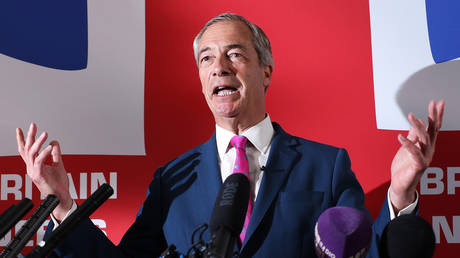 Farage’s Reform UK overtakes Labour in poll for first time
Farage’s Reform UK overtakes Labour in poll for first time
According to a BBC projection, if a general election were held today, Reform UK would receive 30% of the vote, ahead of Labour at 20% and the Conservatives at 15%. However, the next general election is not due until May 2029. The last one was held last year and saw Labour secure a landslide victory, riding a wave of public dissatisfaction with the economic policies of the Tories.
Commenting on his party’s strides, Farage remarked: “In post-war Britain, no one has ever beaten both Labour and the Tories in a local election before. These results are unprecedented… Reform can and will win the next general election.”
UK Prime Minister Keir Starmer said that while he felt a “sharp edge of fury,” he said he understood the voters’ choice while promising to “go further and faster in pursuit of… national renewal.” Meanwhile, Conservative Party leader Kemi Badenoch bluntly acknowledged that the elections were a predictable “bloodbath,” stressing that the Tories must continue work to rebuild trust in the party.
Reform UK’s rise has been driven by voter frustration over high levels of immigration, the rising cost of living, and what many see as years of mismanagement by both major parties. The party campaigned heavily on promises to cut migration – including by small boat crossings – lower taxes, and reduce council spending, positioning itself as the only alternative to what it calls “a failed political establishment.”
-
Site: Zero HedgeThe Wait Is The Price: Quiet Rationing Plagues Canadian Health CareTyler Durden Sat, 05/03/2025 - 08:10
Authored by Vincent Geloso via the American Institute for Economic Research (AIER),
Last month, a video was trending on social media showing a Canadian woman explaining that she had a 13-month wait for a magnetic resonance imaging (MRI) test to check for a brain tumor.
Canada healthcare is horrifying
— Wall Street Apes (@WallStreetApes) March 23, 2025
“Today on how f*cked is Canadian healthcare: I need an MRI to see if I have a f*cking brain tumor. Go ahead guess when it is? Go ahead, guess. It's in 2026”
“My MRI to see if I have a brain tumor is in 2026. It's March 2025 right now”
“If you… pic.twitter.com/fX1S0MD9EPOn X, formerly known as Twitter, community notes popped up to say that the video was misleading. “Priority is decided by physicians, not the province,” wrote one commenter. Another noted that wait times did vary by province.
None of this, however, detracts from the core truths:
-
Canadian health care is not free and it has two prices:
-
the taxes Canadians pay for it
-
and the wait times that make Canadians pay in the form of service rationing.
-
Canada’s publicly provided health care system actually requires rationing in order to contain costs. Because services are offered at no monetary price, demand exceeds the available supply of doctors, equipment, and facilities. If the different provinces (which operate most health care services) wanted to meet the full demand, each would have to raise taxes significantly to fund services. To keep expenditures down (managing the imbalance from public provision) and thus taxes as well, the system relies on rationing through wait times rather than prices.
The rationing keeps many patients away from care facilities or encourages them to avoid dealing with minor but nevertheless problematic ailments. These costs are not visible in taxes paid for health care, but they are true costs that matter to people.
All this may sound like an economist forcing everything into the “econ box,” but the point has also been acknowledged by key architects of public health care systems themselves. Claude Castonguay, who served as Quebec’s Minister of Health during the expansion of publicly provided care, conceded as much in his self-laudatory autobiography. The reality, he explains, is that eliminating rationing would imply significantly higher costs—costs that politicians are generally unwilling to justify through the necessary tax increases. Multiple government reports also take this as an inseparable feature of public provision—even though they do not say it as candidly as I am saying it here.
To illustrate the magnitude of rationing (and the trend), one can examine the evolution of the median number of weeks between referral by a general practitioner and receipt of treatment from 1993 to 2024. In most provinces (except one), the median wait time in 1993 was less than 12 weeks. Today, all provinces are close or exceed 30 weeks. In two provinces, New Brunswick and Prince Edward Island, the median wait times exceed 69 weeks. For some procedures, such as neurosurgery, the wait time (for all provinces) exceeds 46 weeks.
Estimating the full cost of health care rationing is far from straightforward. The central challenge lies in balancing data reliability with the breadth of conditions considered. While some procedures and ailments are well documented, they represent only a subset of those subject to rationing. For many other conditions, data quality is limited or inconsistent, making comprehensive analysis difficult. As a result, most empirical studies focus narrowly on areas where measurement is more robust, leaving much of the total cost unaccounted for.
In 2008, the Canadian Medical Association (CMA) released a study estimating the economic cost of wait times for four major procedures: total joint replacement, cataract surgery, coronary artery bypass graft (CABG), and MRI scans. For the year 2007, the CMA estimated that the cost of waiting amounted to $14.8 billion (CAD). Relative to the size of the Canadian economy at the time, this represented approximately 1.3 percent of GDP. That study did not include, as one former president of the CMA noted, $4.4 billion in foregone government revenues resulting from reduced economic activity. It also does not include the cost of waiting times for new medications.
These procedures do not capture the full scope of delays in the system and only a few procedures—and the analysis focused only on an arbitrary definition of “excessive” wait times. In 2013, the Conference Board of Canada found that adding an extra two additional ailments boosted the cost from $14.8 billion to $20.1 billion.
Another study used a similar method, but considered the cost in terms of lost wages and leisure. It arrived at a figure, for 2023, of $10.6 billion or $8,730 per patient waiting.
One study attempted to estimate the cost of rationing in terms of lives lost.
This may seem callous, but lives lost means lost productivity—a way to approximate the cost of wait times. One study found that one extra week of delay in the period between meeting with a GP and a surgical procedure increased death rates for female patients by 3 per 100,000 population. Given that the loss of a life is estimated at $6.5 million (CAD), this is not a negligible social cost in terms of mortality.
And all of this for what? One could argue that these wait times come with good care once obtained. That is not true either.
Adjusting for the age of population, Canada ranks (out of 30):
-
#28 in doctors
-
#24 in care beds
-
#25 in MRI units
-
#26 in CT scanners
In one comparative study examining care outcomes—such as cancer treatment, patient safety, and procedural success—“Canada performed well on five indicators of clinical quality, but its results on the remaining six were rated as either average or poor.” This is despite, after again adjusting for population age structure, Canada ranking as the highest spender among a group of 30 comparable countries. The reality is that, whatever nuances one wishes to introduce—whether in good faith, pedantically, or simply to troll—the core message of the viral video remains accurate: Canadian health care works well for those who can afford to wait. To which I might add: wait very long.
-
-
Site: Catholic Herald
With just four days to go until the conclave to elect a new pope begins, cardinals are addressing a variety of challenges the next pontiff will have to face. During a flurry of pre-conclave meetings happening in the Vatican, discussions have seen both criticisms of the late pontiff, with a call for more clarity from his successor, but also praise and a call for continuity with Pope Francis’s policies.
Cardinals have now been meeting for eight days in pre-conclave general congregations, during which they are getting to know one another and offering interventions on the state of the world and the Church, to establish a profile for the next Successor of Peter.
During the first general congregations, there was significant criticism of Pope Francis and his legacy among more conservatively minded members of the “old guard”; however, recent interventions have highlighted Francis’s emphasis on evangelisation and synodality.
Weighing in on the profile of the next pope, Italian Cardinal Camillo Ruini, 94, vicar emeritus of Rome, in an open letter to cardinals ahead of the conclave said Francis’s papacy is something “that questions and deeply shakes the Church”.
A conservative giant, Ruini said he hoped the Church of the future would be charitable, but “doctrinally secure, governed according to the law, deeply united within itself”.
He insisted on the need for “certainty of truth and the security of doctrine”, but lamented that Benedict XVI’s papacy was “undermined by his poor aptitude for governing”.
“This is a concern that applies to all times, including the near future,” he said, and stressed the need to overcome both internal and external threats to the Church’s unity.
Likewise, conservative German Cardinal Gerhard Ludwig Müller told Italian newspaper La Reppublica that there was “unanimous appreciation” for Pope Francis’s attention to migrants, the poor, and to overcoming disparities between “the center and the periphery”.
However, he said Francis was “too ambiguous” at times, whereas Benedict XVI offered “perfect theological clarity”.
“Everyone has their own charisms and abilities and I think Pope Francis had them more in the social dimension,” Müller said, voicing his belief that the next pope should provide clarity on Pope Francis’s authorisation for blessings of individuals in same-sex unions, as well as his choice to appoint a woman prefect to the Dicastery for Religious, as it is an “ecclesial body” and not an administrative role.
He also underlined the need to draw a firmer line in dialogue with Islam and with China going forward, not allowing for a “relativistic” attitude toward violent instincts in Islam, and being firm in now allowing “that communists appoint bishops”.
German Cardinal Walter Kasper, 92, also gave an interview to La Reppublica in which he praised Pope Francis’s commitment to synodality and said it ought to be a guide for the future.
“I don’t think we can go back, it would be senseless. I think that we can move forward, even with a new pope,” he said, saying the faithful themselves “voted with their feet” in terms of what they want in a pope when they turned out in droves for Francis’s funeral, which was attended by around 200,000.
Kasper voiced his conviction that the Church will “move forward in the footsteps of Pope Francis. This is his central message: Jesus Christ preached mercy, he lived mercy, and he died for us on the cross out of mercy, and therefore mercy is so central to the faith of the church.”
“I hope that [the cardinals] will reach a consensus very soon on the next pope, in the footsteps of Francis,” he said.
Speaking to journalists after a May 2 general congregation meeting, Colombian Cardinal Jorge Enrique Jimenez Carvajal, 83, archbishop emeritus of Cartagena, said the Church needs a pope who can speak to all corners of the world, “And help to bring a light of hope to so many people who are living such a difficult life.”
“Pope Francis marked the world and marked society,” he said, adding that the next pope can come from anywhere, and that geography doesn’t matter.
“We ask God that he be the best possible. May he have a very big heart where everyone fits, all men, all women, all those who suffer,” he said, stressing the need for “more continuity than anything else”.
During that morning’s session, he said, a bishop had given a speech analysing the word “continuity”, and how to understand the last three papacies – John Paul II, Benedict XVI, and Francis – with the “hermeneutics of continuity”.
“It was very interesting,” Carvajal said, noting that continuity implies certain elements of the past “being born new and the new is being created…the Church cultivates continuity.”
While a certain level of tension in coming to a decision on a new pope is normal, Carvajal said, polarisation is a problem, because “the Church is an institution that doesn’t go for polarisation. In fact, it believes that polarisation, ordinarily or almost always, is harmful.”
“What the Church seeks is more is to promote unity…unity must be built, and it is hard to build, because today it seems different, because there are different situations,” but that is the Church’s task, he said.
 Colombian Cardinal Jorge Enrique Jimenez Carvajal, archbishop emeritus of Cartagena, speaks with journalists outside of the Vatican walls, 2 May 2025. (Credit: Crux/Elise Ann Allen.)
Colombian Cardinal Jorge Enrique Jimenez Carvajal, archbishop emeritus of Cartagena, speaks with journalists outside of the Vatican walls, 2 May 2025. (Credit: Crux/Elise Ann Allen.)
Regardless of whatever decision is made and whoever gets elected, Carvajal said the cardinals are “unanimous” on the need to support the next pope.
Vatican spokesman Matteo Bruni in regular daily press briefings has highlighted several topics being addressed during the general congregations, including the emphasis on evangelisation, the need for the Church to speak to younger generations, and the need for the Gospel to be preached effectively “from the parishes to the Curia” in Rome.
The topics of financial and clerical abuse scandals have also been addressed as “wounds” that continue to afflict the Church, and the need for more awareness so as to identify “concrete paths for its healing”.
One of the most glaring issues the new pope will have to face is the Vatican’s crippling deficit and its looming pension crisis. While Pope Francis took various measures to get on top of the problem, it is unresolved and remains one of the most immediate priorities for the incoming pontiff.
On Wednesday, April 30, several prelates gave presentations on the Vatican’s financial situation, with American Cardinal Kevin Farrell, chair of the Committee for Investments, speaking about its role and activities.
Austrian Cardinal Christoph Schönborn, chair of the Supervisory Commission of Cardinals of the Institute for the Works of Religion (IOR), the so-called Vatican Bank, spoke about its current situation, while Spanish Cardinal Fernando Vérgez Alzaga, president emeritus of the Governorate of Vatican City State, offered details on the Governorate, including some renovation works.
Polish Cardinal Konrad Krajewski, Apostolic Almoner, also spoke about the commitment of the Dicastery for the Service of Charity.
Other topics that have come up in discussions include liturgy, the importance of canon law, and the value of synodality, a buzzword of Francis’s papacy that implies a more collaborative style of leadership with an emphasis on making the church a more welcoming and inclusive place for all its members.
The connections between synodality, collegiality and mission in the Church were highlighted, as was the need to overcome secularism and to overcome polarisation and divisions in society. The value of synodality in this regard was highlighted, “in close connection with episcopal collegiality, as an expression of differentiated co-responsibility,” Bruni said on May 2.
References have also been made to documents of the Second Vatican Council, particularly the apostolic constitutions Lumen Gentium and Gaudium et Spes, and how to foster more priestly and religious vocations.
Reaching a consensus for the new pope will be a challenge for the cardinals, as there are more of them – 135 electors participating, instead of the 115 and 117 of the past two conclaves – and they are on the whole far more diverse, with many being unfamiliar with Rome and unable to speak Italian.
Two electors, Cardinal Antonio Cañizares Llovera, archbishop emeritus of Valencia, and Cardinal John Njue, archbishop emeritus of Nairobi, Kenya, are unable to participate due to illness, meaning the number of electors present in Rome voting will be 133.
 Cardinals walk under the colonnade in St. Peter’s Square after leaving a pre-conclave general congregation meeting, 2 May 2025. (Credit: Crux/Elise Ann Allen.)
Cardinals walk under the colonnade in St. Peter’s Square after leaving a pre-conclave general congregation meeting, 2 May 2025. (Credit: Crux/Elise Ann Allen.)
Carvajal in his comments to journalists noted that “many of us did not know each other” prior to coming to Rome for pre-conclave meetings, but he said the fact that there is so much diversity, and that they are now getting to know each other better, is a gift for the Church.
On the whole, the body of cardinals who will elect Francis’s successor is younger and more diverse, reflecting Pope Francis’s desire for a more global Church that better reflected realities on the ground.
The average age of cardinal-electors (those under 80) is 70 years old; however, there are several who are in their mid-40s and mid-50s, including Cardinal Mykola Bychok of Saints Peter and Paul of Melbourne (Ukrainian), who is 45; Cardinal Giorgio Marengo of Mongolia, 50; Américo Manuel Cardinal Alves Aguiar of Setubal, Portugal, 51; Indian Syro-Malabar Cardinal George Jacob Koovakad, prefect emeritus of interreligious dialogue, 51; and Lithuanian Cardinal Rolandas Cardinal Makrickas, coadjutor archpriest of St. Mary Major, 53.
Some 80 per cent of the cardinal-electors were appointed by Pope Francis, more of whom come from the global south than in previous conclaves.
Whereas 51 per cent of cardinal-electors came from Europe in 2005 and 2013, this year only 43 per cent are from Europe, whereas the percentages of those from Latin America, Asia and the Pacific, and Africa and the Middle East have increased by several percentage points.
This year Latin Americans make up 18 per cent of the cardinal-electors, whereas Asia and Pacific cardinals make up 16 per cent, and cardinals from Africa and the Middle East represent 14 per cent. North American cardinals, who made up 11 per cent in the past two conclaves, are now nine per cent.
With Francis’s appointees, there are now more voting cardinals from Asia and the Pacific than there are from Italy, which marks a significant departure from the past. There has also been a noticeable drop in cardinals from the Curia, going from 27 per cent in 2013 to just 20 per cent now.
There are no serious contenders among the US contingent, apart from Cardinal Robert Prevost, a Chicago native who spent nearly 30 years as a missionary in Peru with his Augustinian order, as he is considered moderate, while the others are viewed as being either too far to the Right, or too far to the Left.
Four cardinal-electors still need to arrive to Rome prior to the start of the conclave May 7, which will begin with Mass and the swearing of the oath of secrecy that morning, and the closing of the Sistine Chapel doors and casting the first vote that evening.
The chimney from which black or white smoke will pour out of after the various ballots has already been installed, and the Sistine Chapel itself is being prepared with a special floor, and tables and chairs for the voting sessions.
After the first vote on Wednesday, 7 May, two votes will take place each morning and each afternoon until a new pope is elected.
Photo: Cardinal Camillo Ruini prays during a papal Mass for the 14th Ordinary General Assembly of the Synod of Bishops at St Peter’s Basilica, Vatican, 25 October 2015. (Photo credit should read ANDREAS SOLARO/AFP via Getty Images.)

The post FEATURE: Cardinals assess Pope Francis’s legacy as they debate Church’s future ahead of conclave first appeared on Catholic Herald.
The post FEATURE: Cardinals assess Pope Francis’s legacy as they debate Church’s future ahead of conclave appeared first on Catholic Herald.
-
Site: Novus Motus LiturgicusBy “the Gospel of Nicodemus”, I mean not the apocryphal gospel of that title, but the passage of St John’s Gospel in which Christ speaks to Nicodemus, chapter 3, verses 1-21. This passage has an interesting and complex history among the readings of the Easter season. For liturgical use, the Roman Rite divides it into two parts, the second of which begins at one of the most famous verses in all Gregory DiPippohttp://www.blogger.com/profile/13295638279418781125noreply@blogger.com0
-
Site: The Remnant Newspaper - Remnant ArticlesVoting for Parolin or Tolentino today, with all due respect for their persons, means risking handing the Church over to a pontificate that may be refined but powerless and dangerous; perhaps inspired in words but divisive in actions; perhaps diplomatic or poetic but disconnected from the pastoral and geopolitical realities that our time demands.






